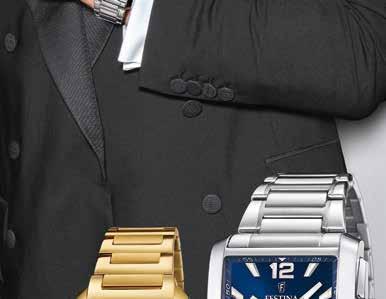

























Dear friends,
On behalf of MINOAN LINES , we would like to welcome you once again to a summer that will be marked by the quality and safety of our modern and environmentally friendly cruise ferries, and we would like to thank you for making MINOAN LINES synonymous with your “journey” for more than 50 years.
Certified to the strictest standards of safety, quality and environmental management, and internationally awarded for the travel experience we offer, we will once again “take you on a journey” with luxury, comfort and quality services on board to guarantee our passengers a perfect travel experience.
For yet another summer we are preparing our “luggage” to explore the unique nature of Crete, the rich beauty of Athens and the cosmopolitan Mediterranean air of Italy, while bringing the colourful “canvas” of Milos even closer to you with daily direct routes to and from the internationally renowned Cycladic island. This year, the MINOAN LINES family welcomes you to an even “greener” summer, in line with our consistent practices and compliance with the strictest environmental standards, constantly seeking to reduce the energy footprint of our fleet. We actively demonstrate our environmental sensitivity and awareness by “embracing” the habit of recycling through the installation of recycling bins and LED lighting on our vessels.
We bring Crete to your every journey. We offer to the internationally acclaimed, rich Cretan cuisine a special place in the à la carte restaurants of FESTOS PALACE and KNOSSOS PALACE. Twelve recipes with pure ingredients from Cretan producers, authentic traditional dishes with fresh ingredients from the Cretan land and sea, with the signature of cook Nektaria Kokkinaki, who, inspired by our roots, prepares a menu as an “ode” to the Minoan land, certified with the quality mark “Cretan Cuisine” of the Region of Crete.
MINOAN LINES travels for Health, for Culture, for Humanity. With a clear vision and strong business ethos, we act with respect and responsibility to improve the communities in which we operate. As part of our Corporate Social Responsibility, we support vulnerable groups, organisations, associations, educational and charitable institutions on an annual basis, with the aim of contributing to the well-being and development of society as a whole.
We would like to thank you for your trust and promise that we will continue to invest with the same zeal as we have been doing for more than 50 years in the high standards of both our ships and our human resources, both on land and at sea, in order to continue to offer you unique trips in Greece and abroad.
We welcome the summer tourist season by “unlocking” the most upgraded travel experience with the floating palaces of MINOAN LINES, KNOSSOS Palace, FESTOS Palace and KYDON Palace and invite you to create new images, experiences and moments with us.
Because at MINOAN LINES, the journey begins from the first moment you think about it. And when you think of “travel”, we want you to think of MINOAN LINES
LucasSigalas CEO of Minoan Lines

Emecalm Travel,




Το Emecalm Travel δεν





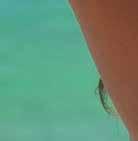






































Έβανς 2, 71201, Ηράκλειο
τηλ: 2810 222245
Κονδυλάκη 31, 71305, Ηράκλειο
τηλ: 2810 252469, 2810 370130
email: info@chronoro.gr
e-shop: chronoro.gr










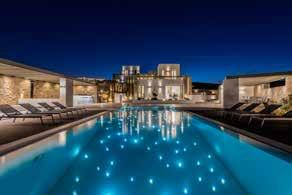

Offices:
Athens: 13-15 Sofokleous Rd, Athens
w w w . r e v i t h i s - r e a l e s t a t e . c o m
D r o s i a : 2 M a r a t h o n o s S t r
w w w . r e v i t h i s . c o m
Mykonos: New Region Drafaki Rd, (Above Piraeus Bank)
w w w . m y k o n o s - r e a l e s t a t e . c o m
Arachova: Old Nation Rd
www.parnassos-realestate.com
Vouliagmeni: Astir Marina Vouliagmenis, South Suburbs
w w w . g r e e k t o p v i l l a s . c o m




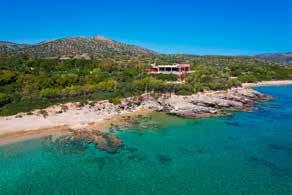



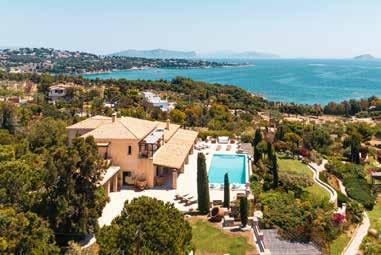




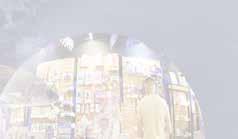











































































“Spilia” means “Cave”.







































ΙΔΙΟΚΤΗΣΙΑ MINOAN LINES S.A.
17, 71202,
Tηλ. 2810-399800, Φαξ: 2810-330308
www.minoan.gr
OWNERSHIP
MINOAN LINES S.A.
Shipping Company 17, 25th Avgoustou str. | Heraklion, Crete - Greece Tel.: +30 2810-399800, Fax: +30 2810-330308
www.minoan.gr
PMS MEDIA
Κηφισίας 312, 152 32, Χαλάνδρι, Αθήνα Τηλ: 210 3212037 info@pmsmedia.gr
ΔΙΕΥΘYΝΤΡΙΑ: Ξανθή Ηλιοπούλου
ΔΙΕΥΘΥΝΤHΣ ΣYΝΤΑΞΗΣ: Θανάσης Τολούδης CREATIVE DIRECTOR: Nίκος Βατσίτσης ART DIRECTOR: Αλέξανδρος
PRODUCTION – PUBLISHING PMS MEDIA
312 Kifisias Ave., 152 32, Chalandri, Athens
Τel.: 210 3212037 info@pmsmedia.gr
MANAGING DIRECTOR: Xanthi Iliopoulou
MANAGING EDITOR: Thanassis Toloudis
CREATIVE DIRECTOR: Nikos Vatsitsis
ART DIRECTOR: Alexandros Bitsaras
CONTRIBUTORS: Maria Atmatzidou, Asteropi Lazaridou, Dimitris Papadopoulos, Ζoe Papadopoulou, Eva Petropoulou
COPY EDITOR: Niki Stathia
TRANSLATION: Evita Lykou
PHOTOS: Andreas Simopoulos
COMMERCIAL DIRECTOR: Stavros Kefalopoulos
ADVERTISING MANAGERS: Giorgos Andreadelis, Lena Konitsa, Kaiti Konitsa, Marifili Papanikolaou, Stella Selianiti, Peggy Stebili
PRINTING: PaperGraph S.A.
Your Free Copy
It is illegal to publish, reproduce, or transmit in whole or part of the magazine without the written permission of the publisher. The MINOAN LINES isn’t responsible for the contributors’ opinions as they are represented on issues.
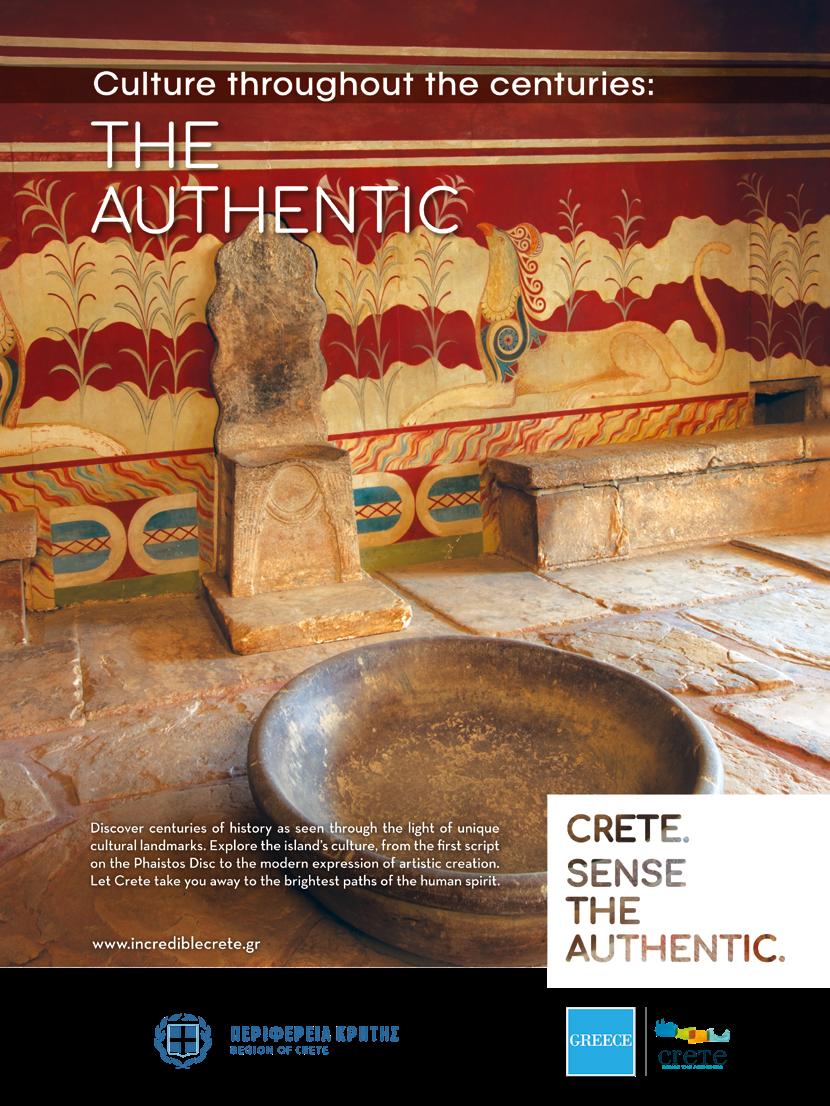











In the flow of History
Myths about women
The island of -geological- treasures 98
Katerina Lehou 108
Let’s take a dip… in a dish!
116
Crete: adventurous by nature


A country that stands for Art

On the cover, the Sarakiniko of Milos and the Dolphin Fresco of Knossos, which once adorned the walls of the Queen's Megaron.







AN IMPORTANT DOCUMENTARY EXHIBITION ON THE SHORT BUT FASCINATING LIFE OF THE FAMOUS BRITISH ARCHAEOLOGIST AND HERO OF THE BATTLE OF CRETE IS HOSTED THESE DAYS AT THE VIKELAIA MUNICIPAL LIBRARY ΟF HERAKLION.
An active, restless, ambitious, adventurous man. A distinguished archaeologist with a great body of research and writing, who approached Cretan archaeology with respect, and at the same time a fearless fighter who linked not only his life but also his death to the “Great Island”. A free soul who has rightly earned a place in the hearts of Cretans, but also in the pages of Cretan history.
John Devitt Stringfellow Pendlebury was born in London on 12 October 1904, graduated in Classical Studies from Pembroke College, Cambridge in 1927, and then studied at the British School at Athens (BSA). He visited Crete for the first time in 1928 and again later the same year, invited by A. Evans at Villa Ariadni.


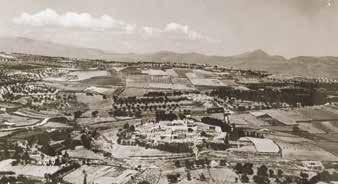

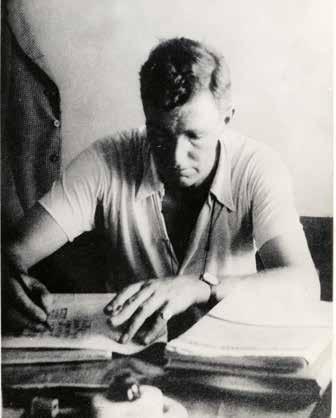
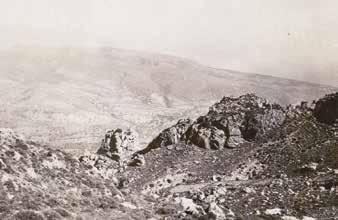
He worked at Knossos, and from 1936 until just before the declaration of World War II, he conducted excavations in eastern Crete. He knew the island very well, having walked for miles in his endless explorations of the countryside, and he spoke Greek well, even the local dialect -it is said that he had almost become a Cretan himself. He deeply loved the island, its people and their culture, both ancient and modern. The outbreak of war found Pendlebury and his family in England, but he rushed back to Heraklion where he served as an officer of the British Army. Essentially, he acted as a liaison between the military leadership of his homeland and the Cretan members of the Resistance. He worked meticulously to prepare the defences before the Battle of Crete and organised the network that formed the first Resistance cell during the German Occupation. Sadly, he died young: he was executed on 22 May 1941 during the Battle of




Crete, having been wounded and captured the day before -he was only 37 years old. Today he rests in the Allied War Cemetery at Souda Bay.
To mark the 120th anniversary of his birth, the Region of Crete, the Municipality of Heraklion, the Vikelaia Municipal Library and the British School at Athens have dedicated a scientific conference in May to his memory, as well as this exhibition, which runs until the 30th of June. In the title we read the phrase “I took up arms and got up to Madara”, which Pendlebury used to describe the age-old tendency of Cretans to take to the mountains in arms, an act he eventually followed himself. Moreover, as he was a great lover of photography, the thousands of photographs he took during the inter-war period are now valuable documents.
The exhibition is based on archival and photographic material from the British School at Athens and the Vikelaia Municipal Library in Heraklion. The bulk of the collection relates to Pendlebury’s archaeological and photographic work in pre-war Crete and is drawn from the John Pendlebury Family Archives at the British School at Athens, part of which is being exhibited in Crete for the first time. As for the archives of the Vikelaia Municipal Library, they highlight the last period of his life and his wartime activities, shedding light on his contribution to the Battle of Crete, his local collaborators and, finally, his death and the preservation of his memory in Heraklion. Of particular importance are the documents from the famous Archive of the German Administration, the “Freiburg Archive” of the Vikelaia Municipal Library, which are being exhibited and presented for the first time, as they were discovered during research for these special events


ON THE OCCASION OF A RECENT EXHIBITION, WE DISCOVER A SELF-FUNDED PRIVATE MUSEUM OF CONTEMPORARY ART IN THE CITY OF HERAKLION THAT IS WELL WORTH A VISIT.
ΒY EVA PETROPOULOU
PHOTOS: HERAKLION MUSEUM OF VISUAL ARTS
KOostis and Eirini Schizakis, both architects and art lovers, began collecting works in the 1980s. Their first acquisition was an engraving by Tassos Alevizos entitled “Eternal” from the series “The Trees will Blossom Again”. Mr Schizakis recalls: “It was a work from 1974, made against the backdrop of the dictatorship. It turned out to be prophetic, since very soon after, the junta fell. We acquired it in 1979-1980”. The Schizakis couple continued to “invest” in the art market and so in May 2000 they decided to found the Heraklion Museum of Visual Arts (HMVA) as a non-profit civil company, starting with a core of 63 works. Mr Schizakis clarifies: “Initially the museum existed only on paper. Until

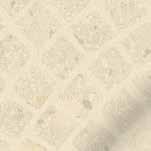





















































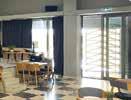











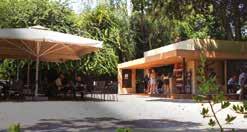






























1. Λευτέρης Κανακάκις, «Πορτρέτο»,
2. Ασπασία Παπαδοπεράκη, «Οι δύο
3. Αντωνία Παπατζανάκη, «18513», 2007,
4. Νίκος
1. Lefteris Kanakakis, “Portrait”, oil on canvas.
2. Aspasia Papadoperaki, “The two friends”, 1978, bronze.
3. Antonia Papatzanaki, “18513”, 2007, stainless steel, plexiglass and light.
4. Nikos Moschos, “Miracle Maker”, 2006, oil on canvas.
a few years later, in 2006, when we found the space to house it and gathered the necessary equipment”. Then began the effort to inventory the works of the collection and publish a catalogue, while the first temporary exhibition was held in early 2007, entitled: “Contemporary art - A look at the visual landscape of Crete”. Since then there have been many exhibitions, not only in the museum itself, but also in other venues in Greece and abroad, for example in Germany and Italy.
Nowadays, the collection of HMVA consists of approximately 600 works, created by about 240 artists. Mr Schizakis adds: “They are remarkable works, some of which are of exceptional importance and significance for contemporary Greek art”.
In addition to the main core of works from 1850 to the present day,

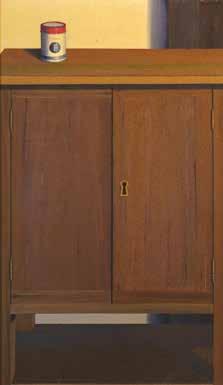


1.
2.
3.
hardboard.
1. Thomas Fanourakis, “Small cabinet”, acrylics on hardboard.
2. Minas Kampitakis, “Chamber Music”, 2015, acrylics on canvas.
3. Maria Grigoriadi, “Untitled”, 1995-1997, oil on canvas.
the collection also includes works given to collectors by artists as mementoes. Moreover, in accordance with the museum’s mission statement, the collection records part of the amateur creation of Crete, so as to make it available to the researchers of tomorrow. “We include in our collection selected works by serious amateurs


μας». Για
https://metheraklion.gr
that simply cannot be ignored. Aristides Vlassis, for example, is considered an amateur because he has not had the opportunity to study due to severe mobility problems, but his talent is enormous”.
One of the Schizakis’ goals is to research, inventory and document the works in their collection, which they hope to do in the near future: “We want each work in our collection to have as much information about it as possible. In other words, we want to collect as much data as possible so that the works can tell their own little story”. And they do it almost entirely with their own capital. The collectors cover all the expenses of the museum themselves, putting in a lot of personal work, time and love. “We are not subsidised by anyone. But it has happened three times that we have received funding from the Ministry of Culture for specific actions”.
On 7 June, the Heraklion Museum of Visual Arts will close its group exhibition “Twigs and Prickly Bushes - A conversation with the treasures of Cretan craftsmanship”, curated by Iris Kritikou, with works by 79 artists. This exhibition, which focuses on folk art, is the eighth that the museum has organised in collaboration with this particular curator and art historian.
Throughout the summer, visitors can admire the museum’s permanent collection entitled “Collection: from 1850 to the present day”. The “Feast of the Senses” exhibition is scheduled for November and December, while the HMVA’s annual group exhibition, entitled “Journey”, will open in January 2025.
Museum Of Visual Arts, https://metheraklion.gr
Above: Aegli Kuczera-Platonos, “Minotaur III”, 1984, oil on canvas. Below: Spyros Vassiliou, “Landscape”, oil on wood.



WE VISIT THE COLOURFUL VILLAGE WITH ITS RICH HISTORY, JUST 15 KILOMETRES FROM HERAKLION, AND DISCOVER THE EXEMPLARY HOSPITALITY IT OFFERS TO VISITORS.
BY DIMITRIS PAPADOPOULOS
Ιn the central square of Epano Archanes, the large letters #ARCHANES, dressed in floral fabric, welcome the visitors. I feel very lucky to be in this beautiful village on a bright and quiet morning.
In the coffee shop “The Square”, the patrons enjoy the peace and greet me. Kindness and hospitality are something you feel. I’m having a coffee. I politely decline the raki they offer me and start walking through the cobbled streets of the village. It is as if time has stood still, expanding to accommodate the elegance and refinement of its inhabitants, who look to the future while respecting the history of their land. The great archaeologist Yannis Sakellarakis once said of his science: “Slices of time, sequences of the present”. He excavated in Archanes and uncovered solid pieces of its history.

Brick red, purple, ochre, salmon, pink, ecru, teal: the neoclassical houses are painted in fantastic colours and the blue and green windows are eye-catching. Bougainvillea, geraniums, roses, basil and lavender add to the beauty of the place. The metal lampposts that light up Archanes in the evening give night walks a charm of yesteryear. I wonder how the village manages to maintain its beauty and uniformity. “When the Turks conquered the Venetian Candia (Heraklion) in 1669, after 22 years of siege, they gave Archanes and their surrounding area to Baroci, the man who had betrayed the city. Archanes became the headquarters of the revolutionaries. During the years of the Cretan State, the town prospered and wine, raisins and olive oil were exported, bringing wealth to the place. The wealthy residents of Archanes, wishing to show their love and longing for union with Greece, built neoclassical houses. On the facades of their houses, they applied the architectural trend introduced in liberated Greece. The result was a unique settlement of architectural interest. The settlement has survived intact” they will tell me.
In Archanes, the past and present blend harmoniously. The history of this rich valley goes back thousands of years. Evidence of the earliest human presence in the area includes stone tools


OX CHOP HOUSE is the new meeting point for meat lovers in Athens. At Ox, the stars are the spit roaster, the wood-fired oven, the charcoal and the frying pan, as they are in the Greek tradition. The menu is comprehensible and from start to finish emanates a meaningful creativity, just as envisioned by the award-winning chef Michalis Nourloglou, who not only signs the menu but is also at the forefront of the open kitchen.
THE WINE LIST has been curated by wine expert Giannis Makris and includes approximately 100+ meat-friendly fine labels, mainly from Greek winemakers, along with choices from international producers. Of course, there is also a wide variety of beers and carefully selected spirits.
DESIGNED with simplicity and minimalism in mind and fully accessible and friendly to people with disabilities, OX is dominated by the earthy tones and comfortable seating.
The focal point is the open kitchen with the Spanish custom-made parilla, while the glass walk-in cellar steals the show with its vaulted ceiling reminiscent of an old cellar.
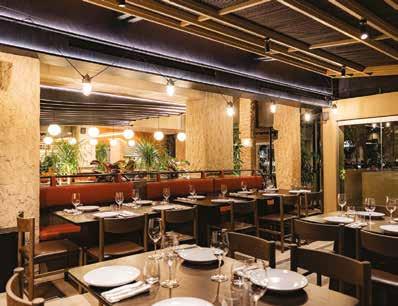
OX CHOP HOUSE
9 Chatzigianni Mexi Street, Athens (behind the Hilton)



Above: The Venetian church of Panagia Keras or Faneromeni is located at the entrance to the village. Its impressive bell tower with decorative reliefs was built in 1857. Left: It is not only the beauty of Archanes, but also the taste of its residents, who take great care of the public spaces and their homes.
and a burial dating from the Late and Final Neolithic period, i.e. the 5th to 4th millennium BC. Remains, ceramics and funerary objects provide important information about the uninterrupted history of the site, while figurines, gold jewellery and Egyptian scarabs testify to an organised social life with intense external contacts from the pre-palatial period onwards. Of course, Archanes flourished during the Minoan period and after that, despite the many changes, it continued to play a leading role in history: the presence of the Mycenaeans, the Romans, the Venetians, the Turks and the Germans left their traces that made the history of the place even more rich.
“I see archaeology as a servant to History”, as Efi Sapouna-Sakellaraki, wife and colleague of Yannis Sakellarakis, said in an interview. Their contribution to the discovery of all the antiquities was invaluable. On the municipal website I read: “Excavations in the area of Archanes began at the beginning of the 20th century, when Stefanos Xanthoudidis first pointed out the existence of antiquities. But it was A. Evans, who began the excavations, who revealed the palatial character of the Minoan complex. Evans’s research in the palatial complex was continued by Yannis Sakellarakis. In 1964, together with Efi, they excavated the Tourkogeitonia and brought to light part of the palace. In 1965, the discovery of the necropolis of Fourni gave a new impetus to their research”. Make a note of these sites and visit them!
Just a few minutes from Knossos, the road to the village is also stunning and can be enjoyed as you drive through olive groves and vineyards. The Kotsifali and Rozaki varieties produce amazing wines, which you will certainly taste in Archanes and probably buy


to take home. As you enter the village you will find the church of Panagia Faneromeni, built in the 14th century. There is also the telescope that Napoleon gave to the owner of the house where he stayed on his way to Egypt. In 1897 the telescope was given to the Revolutionary Assembly in Archanes for the needs of the liberation struggle and ended up in the museum of Panagia Faneromeni. Both the Archaeological and the Folklore Museum are well worth a visit for a better understanding of the region’s historical wealth.
Greece’s first female mayor, Maria Ploumidou, was elected in Archanes in 1975 and served for two consecutive four-year terms. “She loved Archana as the eagle loves the heights and the bees love the beehive” they said of her and her difficult tenure at the beginning of the political transition after seven years of dictatorship. This is how I perceive the inhabitants and the fanatical visitors of this beautiful village. They love everything from gastronomy and delicacies, history and myths to culture and the breath of culture in everyday life -from festivals and plays, classical music ensembles and concerts to marathons and cycling tours. Archanes is waiting for you to discover and, of course, love them.
The stone-built Didaktirio (school) dominates the scene in Archanes -in fact it was the first building project immediately after the 1897-98 revolution.




















The KOMBOLOI MUSEUM is housed in a two storey building in the old town of Nafplion near the church of Agios Spyridon.
The historical journey of the Komboloi (Museum) is exhibited on the first floor through the private collection of the family Evangelinos and Gromitsari.










Old and new kombolois are sold and repaired on the ground floor (Shop and Workshop) mainly from all sorts of materials, mainly organic, such as amber from Baltic sea, “Mastic - Amber”, “Faturan”, wood, seed, horn, coral, bone, shell, artificial resin, crystal, etc, as well as original handmade amber and semiprecious stones jewellery.

During its twenty-year history, the Komboloi Museum has welcomed more than 350.000 visitors.

Staikopoulou 25, Nafplion
Τ: +0030 27520 21618

E: komuseum@otenet.gr www.komboloi.gr



THE NEW PUBLICATION OF THE MILOS MINING MUSEUM “DIALOGUE WITH APHRODITE” BY MADY LYKERIDOU WAS RELEASED ON THE OCCASION OF THE 200TH ANNIVERSARY OF THE DISCOVERY OF VENUS DE MILO, THE MASTERPIECE STATUE ON THE BEAUTIFUL ISLAND OF THE CYCLADES.
BY ASTEROPI LAZARIDOU
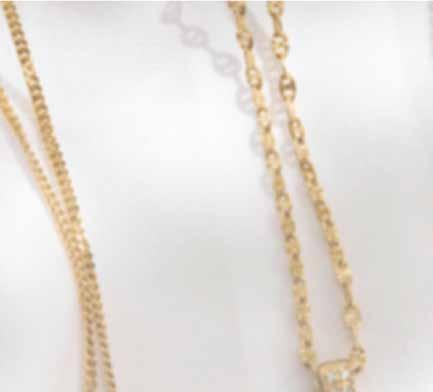


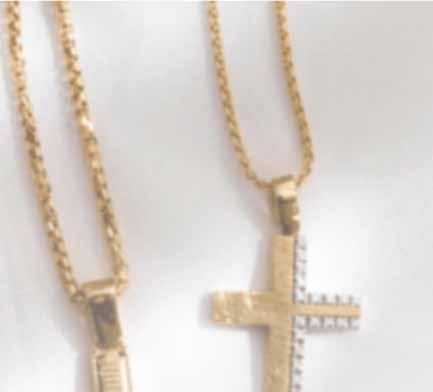


email: info@labyrinth.gr
2810 346380 | Lavirinthos-Kokkiadi: 21 Dikaiosinis Street, Heraklion, tel: +30 2810 346380
2810 330350 | Kokkiadi Jewels: 35 Daidalou Street, Heraklion, tel: + 30 2810 330350
e-shop: kokkiadi.gr
















Αphrodite is the mythological patroness of Milos. You can find her all over the island, in the most likely and unlikely places. Talented photographer Mandy Lykeridou tells us about a unique idea that turned into a photo album encapsulating the love the people of Milos have for their land and its history.
“My connection with Milos goes back to 1999, when I first came here for three days. The beauty of the place and meeting my husband there kept me on the island forever. My professional collaboration with the Milos Mining Museum (MMM) began 15 years ago, when I started photographing educational programmes and cultural activities. Since 2021, my collective photographic work “Dialogue with Aphrodite” has been exhibited at the museum, where it remains until today, with an intermediate stop at the “Greek House” in Paris in November 2022. It was from this exhibition that the idea for the photo album was born. It was a great honour and pleasure for me to complete the first edition of my photo album “Dialogue with Aphrodite” with MMM and with the exclusive funding of the General Secretariat of the Aegean and Island Policy” says Mandy Lykeridou.
The participation of the people of Milos in the album was highly creative: “The idea of involving the descendants of Aphrodite in the project came up in 2020, on the occasion of the 200th anniversary of the discovery of the statue of Venus de Milo on the island.











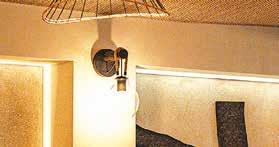



























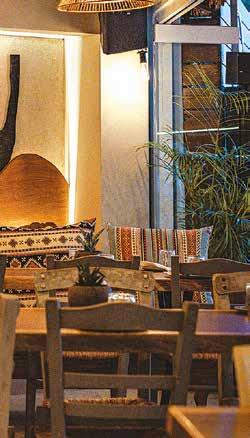














Welcome to the tavern “Maistrali”, a gastronomic destination in Agios Nikolaos, in the prefecture of Lasithi. Located on the beautiful Kitroplatia Beach with a magni�icent view of the sea, it offers a unique experience that combines the unparalleled natural beauty of Crete with the hearty �lavours of Mediterranean and Cretan cuisine. At “Maistrali” you can enjoy a variety of delicious dishes made with pure local ingredients, highlighting the traditional gastronomy of the island. Our creations are based on the authentic recipes of Crete, enriched with the creativity and passion of our chefs.
To accompany your meal, our wine cellar offers a �ine collection of renowned wines from the best wineries of Crete and the rest of Greece. Come and enjoy an unforgettable culinary journey at “Maistrali”, where tradition meets quality and the sea becomes the ultimate companion of your enjoyment.





Through an open call, I invited the island’s inhabitants to creatively intervene in my photographic collection “Venuses de Milo”, using various forms of expression such as texts, drawings, paintings and collages. I would go to the homes of the residents who wished to participate and leave them the photo of their choice along with a box of paints and various materials, giving them a day to think and feel how they would communicate with their Aphrodite. Another place to reach out to residents was in cafes and coffee shops, where people were more spontaneous. The project started in April 2020 under the unprecedented conditions of the pandemic and ended in July of the same year with 132 participants aged 5 to 85!
”Residents expressed themselves freely, creating new images with multiple messages, building bridges of communication with their own expatriated treasure. The result of this free expression was the creation of 16 unique collective works”. What associations does this masterpiece evoke in her? “The Venus de Milo is one of the most important sculptures in world art history.
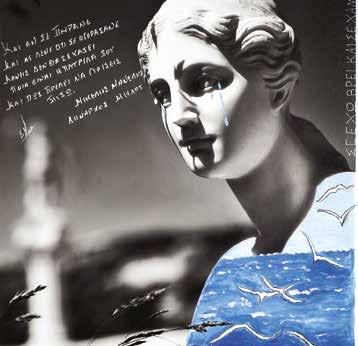

But it is much more than a famous sculpture, which is why it has inspired artists from all over the world and from all art forms over the centuries. It represents the power and influence that women have in the world. Through my work, I rediscover the myth and meaning of Aphrodite, offering new interpretations and provoking thoughts about beauty, love, expatriation, loss and the position of women in modern society”.
How did she start looking for Venuses all over the island? “As I always carry my camera in my bag, the Venus photo shoot was never planned, at least not at the beginning. I remember the first click in a courtyard in Adamantas 10 years ago, and since then I have photographed her wherever I run into her. In time, when I decided to start the project “Venuses de Milo”, something magical









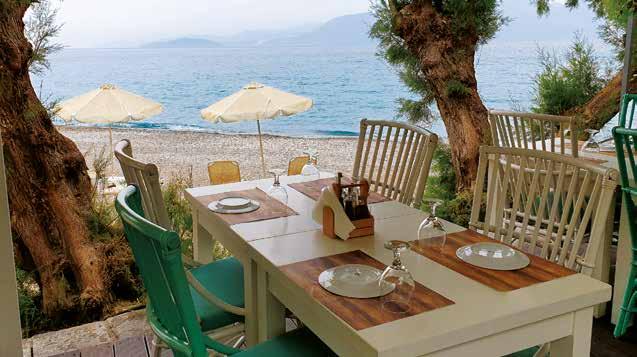
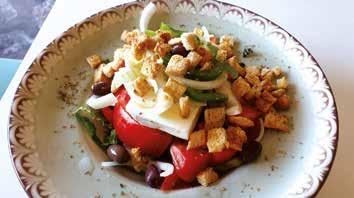
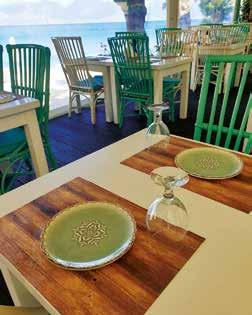
Enjoy delicious meat and seafood on bbq, mama’s cooking of local specialties, an exquisite wine selection and a magical seaside... Family owned, serving with love, since 1978. Your eating place in Agios Nikolaos.
5 Akti Pagalou, Kitroplatia, Agios Nikolaos, tel. 28410 83168
Facebook: FarosFamilyRestaurant
https://madylykeridou.com/
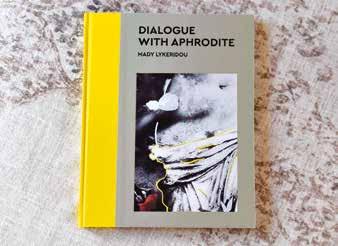
happened: I started to see her everywhere -in the pharmacy, in the souvlaki shop, at the cardiologist... It began to be like the lost treasure game. When I talked to the locals, they all knew how to point me to a Venus”.
There were also a few mystical moments: “A very special photo shoot was Venus with the water lilies. In a private garden in Agia Marina, Venus was standing in the middle of a pond, her features altered by the passage of time. She was 100 years old, the gardeners told me. I chose to photograph her shadow in the water, softening the wear and tear of time.
”Each Venus I photographed had its own story and it was very touching and in a strange way I became attached to all these different Venuses. Every time I pass by their homes, I take a quick nostalgic look”.
The book is available at the Milos Mining Museum https://www. milosminingmuseum.com/ and photographer Mandy Lykeridou https://madylykeridou.com/





ΑΝΑΒΑΘΜΙΣΜΈΝΗ
THE ARCHAEOLOGICAL MUSEUM OF AGIOS NIKOLAOS, WHICH HOUSES IMPORTANT FINDS FROM EASTERN CRETE, HAS BEEN RENOVATED AND EXPANDED TO OFFER VISITORS A MODERN APPROACH TO THE HISTORICAL PAST.
ΑΠΟ ΤΗΝ ΕΥΑ ΠΕΤΡΟΠΟΥΛΟΥ ΒY EVA PETROPOULOU
PHOTOS: JEFF VANDERPOOL

Ιn the 1960s, the first archaeological collection was established in eastern Crete with the aim of preserving, protecting and highlighting the findings of the excavations carried out there, both by the local Ephorate of Antiquities and by foreign archaeological schools. Until then, the most important ones were transferred to the Archaeological Museum of Heraklion, while the minor antiquities remained in the area.
The decision to establish a museum in Agios Nikolaos, the seat of the Prefecture of Lasithi, was formalised in 1961. The architectural design was entrusted to the eminent Greek architect Patroclus Karantinos. The Archaeological Museum of Agios Nikolaos opened its doors to the public in 1969, initially under the jurisdiction of the Ephorate of Antiquities of Heraklion. In 1973, an independent Ephorate was established in Lasithi, and the Museum of Agios Nikolaos became the headquarters of the new Archaeological Service, but without sufficient or suitable building infrastructure. Archaeologist Chrysa Sofianou, head of the Ephorate of Antiquities of Lasithi, explains: “It was then that the lack of exhibition and storage space gradually became apparent, and this very quickly


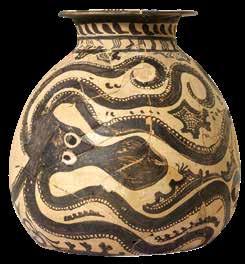
Above: Clay alabastron decorated in the “Marine Style”, Makrigialos, Neopalatial period.
Left: Representation of a Minoan chambered tomb from Gra Lygia, Ierapetra.
exceeded the capacity for storing and exhibiting antiquities. The weaknesses identified in the functioning of the museum led the former Ephorate of Prehistoric and Classical Antiquities to undertake a long campaign to ensure the extension and upgrading of the existing building, with the creation of a modern infrastructure. At the same time, a new permanent exhibition had to be created that would have the potential to display the numerous finds from the old and new excavations, but also to present the history and physiognomy of eastern Crete through a clear central theme and narrative path”.
Finally, the extension of the Agios Nikolaos Museum, designed by the architect Michael Doris, was carried out between 2011 and 2015. It was a major project that required funding from three NSRFs and took 12 years to complete, with many obstacles along the way. Ms Sofianou responds to complaints about delays. “The truth is that there were very few people working on this project, and they were faced with great bureaucratic difficulties, the consequences of the pandemic and the war in Ukraine, which increased the costs”.
The ground plan of the building retains the old structure and adds a new wing on three levels, which contains additional exhibition space and the main utility facilities. The lowest level includes warehouses, workshops and engineering facilities. The central building complements the original building and houses the reception and exhibition areas, with new display cases, special structures and lighting. The upper level houses the offices of the Ephorate of Antiquities.
The building has a total area of almost 3,000 square metres, of which 1,045 square metres is exhibition space (a huge difference compared to the 450 square metres of the old museum). As Klio Zervaki, conservator-museologist, cultural documentation special-
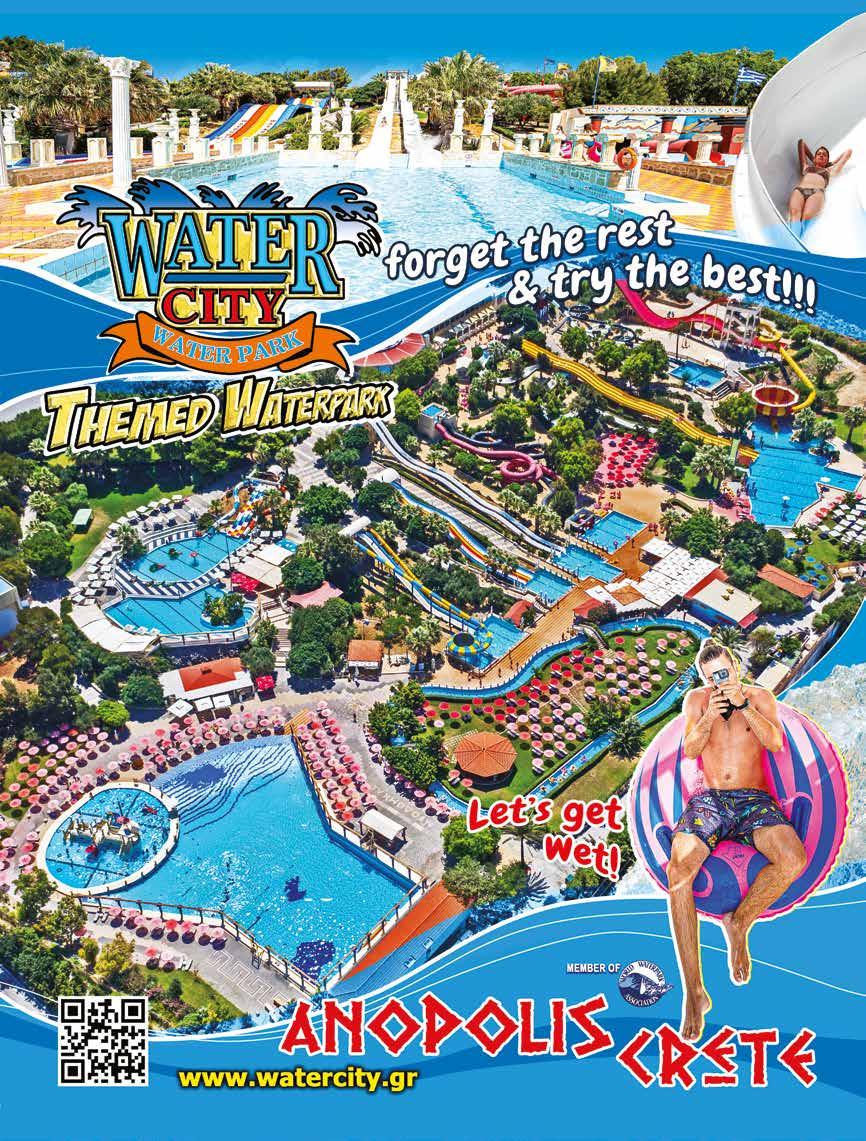

Κωνσταντίνου
ist and head of the conservation department of the Ephorate of Antiquities of Lasithi, explains, the idea for organising the new exhibition was based on modern concepts of museology: “Today, a comprehensive approach to the historical past is sought through the material remains of human civilisation. Here, too, the emphasis has been on highlighting the evolution over time, the continuous human presence in the area and the cultural continuity from the Final Neolithic period to the early Byzantine period”.
The 1,945 objects in the new museum -around 35% of which are on display for the first time- are presented in a way that helps visitors understand important aspects of life in the region, such as the economy, religion, daily life and burial customs.
According to Ms Zervaki, but also to the general public, the museographic tools/findings used to enhance the museum experience are of great interest. A few examples? “The recreation of the sense of the sea in room A4, where the Minoan coastal settlements of Mochlos, Makrigialos and Chrysi are presented, with the addition of a glass floor with sand underneath. There are also displays-dioramas of an excavation in the introductory room A1, a rock that simulates the Peak Sanctuaries and the display of the Minoan tomb of Gra Lygia in Ierapetra. All of this makes the visit much more interesting and exciting. Finally, the many free finds outside the showcases increase the immediacy of observation for the visitor and create a sense of intimacy”.
74KonstantinouPalaiologouStreet,AgiosNikolaos,LasithiPrefecture www.agiosnikolaosmuseum.gr


Αbove: Skull of an athlete with a gold wreath, Kamara, Roman period.
Left: Life in the cities of eastern Crete from the Hellenistic to the early Byzantine period, in room A11 of the museum.













Α

part from its beauty, Sitia also has a gastronomic surprise in store for us: Kouvarakis Xigalo Sitia, a wonderful cheese product with a protected designation of origin, made with sheep’s and goat’s milk from the former province of Sitia, using local breeds of sheep and goats.
The product is said to have an ancient history, perhaps as far back as the Minoan era. Kouvarakis Xigalo PDO Sitia is white in colour, spreadable - slightly grainy in texture and has a mildly salty - sour taste. Its proteins and fats are in perfect harmony and it is delightfully tasty. It is low in lactose as a result of natural fermentation and has a beneficial effect on digestion.
It can be enjoyed on its own or as an ideal accompaniment to bread, rusks, chips and many other dishes.






The Kouvarakis family dairy and cheese company was founded in Sitia in 1979 and continues to offer pure products to this day. It maintains tradition and pays attention to quality, while using modern methods and safe production processes. You can find Kouvarakis Xigalo PDO Sitia in many large stores, small grocery stores, restaurants and distribution chains throughout the country. As well as other wonderful products of the company. stores, grocery
HEAD OFFICE - CHEESE DAIRY Hamezi, Sitia
Wholesale orders: +30 28430.71555
CENTRAL STORE: 22 Papanastasiou Street, Sitia, Crete


THE FOUNDER, ARTISTIC DIRECTOR AND THE SOUL OF THE “LABYRINTH” MUSICAL WORKSHOP TALKS TO US ABOUT THIS CULTURAL MEETING POINT THAT ATTRACTS A LARGE NUMBER OF MUSIC LOVERS EVERY SUMMER, BUT ALSO ABOUT HIS LIFE, WHICH IS PARTICULARLY LINKED TO CRETAN MUSIC.

Kelly Thoma and Ross Daly in 2017 at a concert at the MIT Chapel in Boston, a temple created on the university campus for worshippers of all faiths.
2022.
Below: Concert of Kelly Thoma with the MITOS Orchestra at the “Labyrinth”, 2022
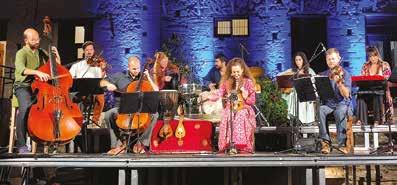

Ηe was born in Norfolk, England in September 1952 to Irish parents. Due to his father’s job -he worked in computer development- they lived in the USA, Canada and Japan, while thanks to his mother -who was a musician herself- he started learning music at the age of 5. He was introduced to the sounds of the East at the age of 14. As he says, he realised early on that for him music was “the language of my dialogue with that which I perceive to be sacred”. His quest led him to the traditions of the Middle East, Central Asia and India, where he discovered the musical archetypes he was looking for. So he decided to put aside, for a while, the classical guitar he had been playing. He travelled extensively, studying under many of the world’s greatest masters of modal traditions and, after some time, the classical guitar was consigned to history! But what is modal music? Ross tries to explain it in a nutshell: “A composite, comprehensive form of traditional music that includes tonal material (scale or multiple scales), accumulated phraseology and melodic «archetypes», as well as specific references to other modes”. In 1970 and 1972, Ross visited Crete and loved it so much that he made it his home in 1975. He lived in Chania until 1981 and moved to Heraklion in 1982. His apprenticeship with the Cretan lyra virtuoso Kostas Mountakis began back in 1976: “At that time he lived in Stavromenos, Rethymno, so I would often go there to meet him. This continued until his death in 1991”. As for the “Labyrinth”, it began as a group of friends: “Its creation was not the result of a decision. We started out as a study group. We wanted to explore modal traditions, so already at that time we were inviting musicians from abroad. This first core consisted of Michalis, Vassilis
and Mitsos Stavrakakis, Babis Doulgerakis, Giorgos Xylouris, Spyridoula Toutoudaki, Giorgos Lagadinos, Achilleas Persidis and Ilias Papadopoulos. Later more people joined in, the circle grew”. But what exactly is the “Labyrinth”? Ross explains: “A musical workshop and at the same time a space for interaction between artists, focusing on traditional world music idioms, especially modal ones”. Which has been producing culture for years, we have to add. Does culture in Greece get the attention it deserves? “No... Although it is the «heavy industry» of Greece, unfortunately it is treated very superficially and carelessly by the Greek state; and that is a pity...”.
In 1985-1987 he moved back to Chania and in 1987 to the capital. “The «Labyrinth» wandered as a guest in various music schools in Athens, until it acquired a «base» in Petralona in 1996. Back then it was a workshop, a music band and a record company, all at the same time”. The first seminars were organised in Athens in 1997, and it gradually began to take on the characteristics we see today. In September 2002, it moved into a renovated mansion in Houdetsi, where each summer it organises fast-paced courses focusing on the modal traditions of the Balkans, the Middle East, Central Asia, India and North Africa, as well as concerts. In 2016, a network of “Labyrinth” branches began to be set up in

Omer Erdogdular with his students during a seminar in Houdetsi.
other countries: in Spain, Italy, Canada, Cyprus and Belgium, with exactly the same “philosophy” and actions. Ross adds: “At the same time, during the pandemic we launched labyrinthonline. org, based in San Francisco, which is still up and running”. Many people remember fondly the Houdetsi Festival which was organised by the “Labyrinth” from 2010 to 2016. It was so popular with the public that thousands of people flocked to it every summer. But it was the sheer scale of the event that put an end to the festival: “We ended up with 50,000 people, a number that

Ross Daly at his home in Archanes, playing Afghan rubab.
was far too large, considering that the village didn’t have the infrastructure. I think it was not safe under those circumstances. That’s why we stopped it. It also went off target”.
After the earthquake of 2021, which caused extensive damage to the Houdetsi mansion, but also due to chronic lack of maintenance of the building, the “Labyrinth” had to relocate again. At the time of writing, the move to the new building, a former olive mill opposite the mansion, was already finished.
“We are making great efforts to complete, with the help of a European programme, the modifications on the building granted to us by the Municipality of Archanes-Asterousia. Unfortunately, the first refurbishment that took place before it was handed over to us had significant deficiencies that needed to be addressed in order for the facility to function properly. However, I believe that very soon we will have completed 80-85% of the work”.
The good news is that the beautiful garden of the mansion, which has hosted so many unforgettable concerts, will remain in use: concerts will continue to take place there, while classes will be held in the new building. This summer, 31 weekly seminars are scheduled from July to September, as well as concerts, which will be announced soon on the musical workshop’s website.
The “Labyrinth” has so far welcomed students from 40 different countries, which is very important for Ross: “We are very interested in the dialogue between all these people and cultures. Historically, it is through this dialogue that the traditions we study were created, all this variety and beauty of sound, and their continuation and development depends precisely on this dialogue”. A development that is unstoppable, even if the problems sometimes seem insurmountable: “The Middle East is facing enormous difficulties, unfortunately mainly due to Western interference. So many of the musicians who come to us are refugees in Europe who can no longer return home”. Over the years, Ross Daly’s work has made him an internationally recognised expert on the rich musical tradition of Crete, while his
compositional work draws on his years of experience, research and study. He has released more than 35 albums of his own compositions and arrangements of traditional songs. In 1991 he modified the Cretan lyra, making some constructional changes and adding sympathetic strings. As he explains, “the sympathetic strings enrich the sound, creating a resonant «aura» around the melody. They are often used in India, but are also found in the Bulgarian lyre. Here they were in use to some extent in the Apokoronas area of Chania, where they would use one to four sympathetic strings”. In the summer of 2004, he was the artistic director of the cultural programme for the Olympic city of Heraklion, and in 2023 he was awarded an honorary doctorate from the National and Kapodistrian University of Athens. He has performed at the most important festivals and concert halls around the world,

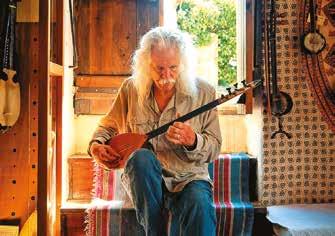
With his bulgari in hand, Ross Daly at the “Labyrinth”.
Left: Musical instruments from India and Turkey, from the collection of Ross
collaborated with renowned Greek and foreign musicians and is the originator of the term “Contemporary Modal Music”: “The term refers to contemporary musical compositions that draw inspiration from the wider field of modal traditions, which are mainly, but not exclusively, located in a wide geographical area from West Africa to Western China”.
In other news, Ross Daly is currently working on the publication of a book containing recordings from the last five years, complete with a QR code: “Essentially, this book will accompany the recordings and will include stories, opinions and quips from me and my collaborators who were involved in those recordings. A multifaceted work that, in my opinion, will be interesting because the reader will become part of the daily life of musicians. I hope to finish in 2024”.
“Labyrinth” Musical Workshop, Houdetsi, Heraklion https://labyrinthmusic.gr


ΜΕ ΤΗΝ ΙΔΙΑΙΤΕΡΗ

THE VENETIAN AND OTTOMAN FOUNTAINS OF HERAKLION, SOME WELL PRESERVED AND OTHERS WITH THE SIGNS OF TIME VISIBLE ON THEM, WITH THEIR SPECIAL ARCHITECTURE, CONTINUE TO BE A REFERENCE POINT FOR THE CITY’S LONG HISTORY.
ΣΤΗ ΡΟΗ ΤΗΣ ΙΣΤΟΡ
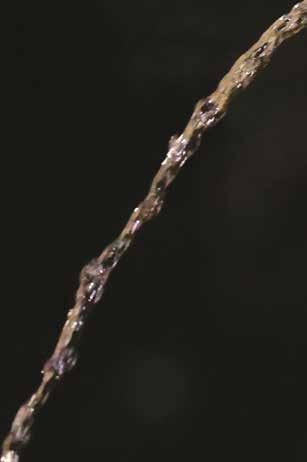

Morosini
They were “born” to cater to the needs of the residents of the Great Fortress of Chandax or Candia, that is, the city of Heraklion, with its rich history and various names over time. Although there were wells inside the castle, the lack of drinking water was always a serious problem. To put an end to the water shortage once and for all, in 1628 the Captain-General (a position held by senior administrators of the Republic of Venice) Francesco Morosini built a 15 km aqueduct and brought water to the city from the springs of Mount Juktas using a pioneering system of pipes. Venetian fountains, with their crystal clear water and elaborate decorations, have always been a source of refreshment for the thirsty city. The same was true later, during the Ottoman period, when sebils, the public fountains, adorned streets and squares.
“...both the conquering Venetians, Turks, Arabs, etc., and the now free Cretans, never stopped building fountains, thus perpetuating an age-old custom through which can be seen the charity of providing free water to people regardless of race, religion and origin” writes Michalis Emm. Paterakis, in the book “Fountains and Fortresses of Crete” (Sfakianos Publications). Some of the Venetian and Turkish fountains have survived to the present day -some extremely well preserved, others not as well as they should be, but all of them deserve our attention as monuments-witnesses to a turbulent but extremely important past.
The emblematic fountain in the centre of Heraklion, with its unique design concept known as the “Lions”, was named after the aforementioned Francesco Morosini and is undoubtedly the most beautiful. Since its inauguration in 1628, it has been a point of reference for locals and visitors alike, with its mermen, dolphins, nymphs, sea dragons, finely carved reliefs of mythological figures, and the imposing lions -a symbol of the power and authority of the Venetians- from whose mouths flowed the water of the ancient sacred mountain of Juktas. Its octagonal shape, in addition to its architectural charm, helped to accommodate more people -up to forty people could dip their containers in the cistern at the same time. At the top of the fountain stood a huge statue of the god Poseidon with his trident, which was destroyed by an earthquake or by the Turkish conquerors, who made further alterations to the monument. Although it no longer supplies drinking water, after intensive maintenance the fountain has been restored to its former glory -and continues to charm passers-by.

Επάνω: Η εμβληματική κρήνη
Morosini,
Bembo
Above: The iconic Morosini fountain, also known as the “Lions”.
Right: The Venetian fountain Bembo and the charity or Hatzi Ibrahim Aga fountain.

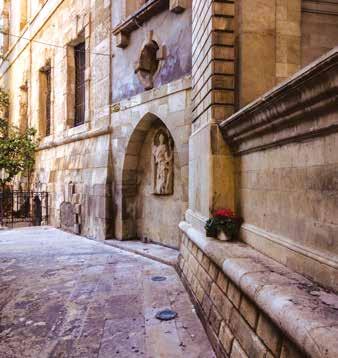

Sagredo (αριστερά) και Priuli (κάτω).
Above: The Turkish Idomeneas fountain. The Venetian fountains of Sagredo (left) and Priuli (bellow).

The first public fountain of Chandax owes its name to the Captain-General Gianmatteo Bembo, who built it in 15521554, for the first time drawing water from springs outside the Fortress. Although only the façade remains today, it is still impressive in the form of an ancient temple, with columns, metopes and capitals decorated with Venetian coats of arms, Gothic and Renaissance elements, with floral motifs on the spout and a large headless Roman statue, perhaps of Asclepius (the god of medicine) or an ancient Greek philosopher, dominating the centre. In front of its base stands an ancient marble sarcophagus. It is said that the statue was previously painted black, while its cloak was painted white. The fountain impresses those who pass by Kornaros Square -named after the author of “Erotokritos”- next to the Turkish fountain of Hatzi Ibrahim Aga which was built later.
Walking down the narrow alley on the north-west side of the Loggia -the imposing historic building where noblemen and dignitaries once gathered and which now houses the City Hall- one comes across a beautiful walled fountain, the Sagredo. It is named after Duke Giovanni Sagredo, who was instrumental in its construction between 1602 and 1604. The relief of a female figure, probably representing Crete herself, is still preserved between two columns, holding a club in one hand and a shield in the other. At the bottom of the fountain there was a sarcophagus that served as a trough and was decorated with a relief of the Annunciation of the Virgin Mary, which was either stolen or destroyed in the bombing during the Second World War. Originally located on the western side of the church of Agios Titos, it was moved to its present location during the restoration of the unique monument of the Loggia.
Another impressive Venetian fountain of Renaissance architecture, with a façade that is a true work of art, is preserved behind the Bodossakeio Primary School, opposite the Gate of Dermatas (in the middle of the coastal wall of Chandax). With elaborately decorated Corinthian style columns, pillars and capitals, niches and metopes and a triangular pediment, the fountain is truly unique. It was built in 1666, by the Captain-
General Antonio Priuli, at the end of the long siege of the Fortress by the Ottomans. The besiegers had cut off the water supply to Heraklion and the people were suffering from unbearable thirst. That’s when Priuli discovered a vein of water in the moat and built this fountain to save the inhabitants of the Fortress. In recognition of the bravery of the besieged Venetians and Cretans, the Ottoman conquerors renamed it the Fountain of Delimarkos (brave Markos) in honour of Saint Mark, symbol of the Republic of Venice.


Above: The Turkish Yenicar Aga fountain.
Left: The Turkish Haniali fountain.
After walking through the Central Market of Heraklion, you will end up in Kornaros Square. Here, next to the Venetian Bembo fountain, stands out the Turkish one, the circular vaulted sebil with arched windows and springs surrounded by troughs. It was built in 1776 by Hatzi Ibrahim Aga, who donated almost his entire fortune so that the fountain would cool the inhabitants of the Great Fortress with drinking water and they would thank the creator or forgive his loved ones who had died. The sebils, public fountains of a charitable nature, satisfied domestic and religious needs, but also served as a place where women could meet to catch up on their news.
The square was dominated by the Mosque of the Valide Sultan (Royal Mother), that is the Church of the Saviour (San Salvatore), which had been converted into a mosque, and many Muslims of the time gathered around the Turkish sebil to rest or wash before entering the mosque. This particular fountain, the only one of its kind to survive to this day, the famous Koubes, a vaulted monument from the city’s Turkish occupation past, operates as a municipal coffee shop -and continues to quench the thirst of residents and visitors, albeit in a different way.
Behind the Historical Museum of Heraklion is another Turkish fountain, that of Idomeneas, built at the end of the 17th century. Its name may refer to the mythical Idomeneus, grandson of the legendary Minos, who became king of Crete and was famous for his bravery in the Trojan War, but it is actually named after the doctor Idomeneas Markatatis, as the fountain was originally located outside his house. Two imposing columns, capitals with floral motifs and a marble slab with impressive relief decorations adorn the well-preserved fountain. In olden times, running water must have flowed abundantly from the hole in the lower part of the slab.
It once adorned the Serai (Ottoman palace) of Haniali Bey. Today, however, the Turkish fountain of Haniali adorns the outer gate of Agios Georgios (one of the central gates of Chandax), below the statue of Crete-born Eleftherios Venizelos, Greece’s leading political figure, adding its own historical touch. With the familiar arched construction decorated with floral motifs, the precious water would flow from the spout into a marble basin to cool the people of Heraklion.
Walking up Ikaros Avenue, a few metres after the Haniali Fountain, next to the Epigraphic Collection, is the Yenicar Aga Fountain. It has not always been here -originally it adorned the mansion of the commander of the Janissary Battalion, which was destroyed. Fortunately the fountain survived, and its arched construction impresses with the floral motif at the top, the two large pillars with relief rosettes, and the elaborately decorated spout. The water that once quenched the thirst of passers-by fell into the marble trough with its rich relief decoration.
THE TALENTED ACTOR TALKS ABOUT THE ISLAND OF HIS CHILDHOOD AND HIS ROLES THAT HAVE TOUCHED THE HEARTS OF ΤΗOUSANDS OF VIEWERS.
BY ASTEROPI LAZARIDOU
PHOTOS: ANDREAS SIMOPOULOS
ΜΑΛΛΙΑ / ΜΑΚΙΓΙΑΖ: MORFE HAIR / MAKEUP: MORFE
He is only 28 years old and already counts ten successful and very full years in the acting world; since he acted in a very successful series at the age of 17, while he was still a high school student. Later, his part in “Wild Bees” (ANT1) was a landmark moment for him to showcase his talent, but also to speak openly about diversity and acceptance, inspiring many young people. From the T-shirts he promoted with messages of acceptance and love, which became a hit, to the very interesting TV and theatre works in which he has starred, Dimitris Tsiklis is an actor who wins you over from the first moment with his disarming honesty.
You come from Crete. Is it true that Crete is like a country in itself? Crete is my country! My homeland, my family, all my summers and my childhood memories. Every time I go back, I see what has changed in my life, what hasn’t and where I want to go. It works introspectively for me. There I am like a fish that swims on its own seabed and knows the waters well. Ever since I learned to drive, I used to take my dad’s pick-up, blast the music and go around the island. I’m always discovering places I haven’t seen, but even the ones I’ve seen I see with different eyes when I go back. Crete is different every time and is definitely the ultimate road trip island.


What are your favourite places in Crete?
My parents are from Sfakia, which I adore, but I have wonderful memories and favourite places all over the island. I am particularly fond of Heraklion for many reasons. I have experienced holiday eve celebrations where everyone is out early in the pedestrian streets and squares. Crete has magical variations. One moment you’re in the mountains and the next you’re on the most perfect beach. I love Agiofarago in Heraklion, which leads to a dream beach.
This year you also starred in the highly successful ERT TV series “The Beach”, which focuses on Matala, Heraklion, in its legendary era. Interesting coincidence... Matala is a magical place that remains unchanged. All those rocks, the caves, the natural beauty, the connection with the flower children of a bygone era. Every time I go there, I wonder how many different lives have passed through there, how many people have slept in the arms of the sea and nature. As for my part in the series, it’s the first time I’ve played a Cretan, named Markos like my grandfather. When I was researching the role, I was thinking of my grandfather. My grandfather was the age I play in the series when my mother was born in Crete. I love these coincidences. As for the beach itself, the hippies knew what they were doing, they didn’t choose it by
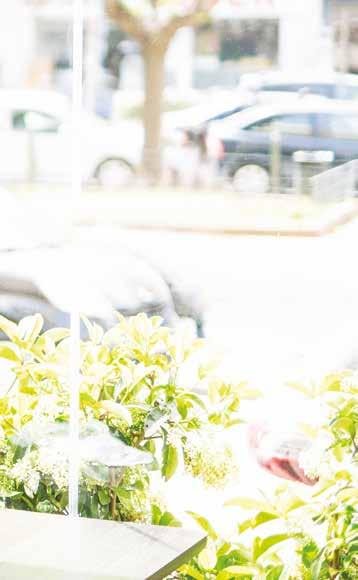
When I was researching the role, I was thinking of my grandfather. He was the age I play in the series when my mother was born in Crete. I love these coincidences
accident. From there you have a view of the endless blue. This place fills up with people all year round when the weather is good for swimming.
How important was your part in “Wild Bees” for your career?
It was definitely a landmark. I played a gay boy, and through him and a similar part in the play “The Swallow” that followed, many young people who felt stuck because of their sexual preferences saw me as someone they could open up to and talk to. We all suffer from things, life is difficult and full of challenges. But to be attacked for who you are is inhuman. I received so many messages on social media every day. They sent me gifts, shared very personal experiences, came to the theatre and cried in my arms. What’s touching is that some of these young people came to the play with their parents, using it as a means of being heard and accepted.
Is that how the idea of T-shirts came about?
One of the key messages is “The world has bigger problems than boys who kiss boys and girls who kiss girls”. The idea emerged when I saw how obsessed the media was with the gay kiss in “Wild Bees”. As if they were shocked by a kiss, when a kiss is nothing more than an expression of love. That’s when I realised how much I don’t want to talk about the wrong things, to analyse over and

https://www.instagram.com/dimitris.tsiklis/?hl=en
https://parostshirtshop.com/product-category/the-t-shirt-shop-xdimitris-tsiklis/
over again what should be self-evident in our society, while society still treats a manifestation of love as a problem.
Do you think it has become “fashionable” to talk about inclusivity, even to people who don’t really know what it is?
I don’t believe in fashions. I believe in the timeless quality of human existence, the need to love and be loved. As much as we hear horrible things around us, about hate attacks and horrible crimes, I still believe that there are people who live for the collective, who live to contribute; that’s who I want to see. And to have a positive influence for good on people who have never felt love and that’s why they are so cruel.
Has the art of acting helped you with this deep understanding?
Of course! I like to interpret roles with extreme attitudes. There you can learn more about the human condition and its darkness. I think we are all treading in a grey area. We are neither good nor bad, we are both. In some people’s stories, we are the bad guys. That is why my work teaches me not to judge. To listen carefully before speaking and try to understand the other person in depth.
What does being an actor mean to you?
The most accurate definition of our job is “anthropologist”. We are observers of the human condition. This is exactly why I love Crete so much. It gives you this sense of freedom and that everything is acceptable there. We are made to be outdoors, in nature. Not in the houses we built. Being close to nature makes you feel orgasmic. If you walk barefoot, you are grounded, your foot gets used to it and is not bothered by stones and rough terrain.
One of your most characteristic traits is that you retain a childlike enthusiasm for things. Share with us a very vivid memory from your childhood...
I’m going to talk about Crete again... When I was young and learning about Knossos and the Minoan Civilisation at school, I was so impressed that I used to ask my parents every day to go to Heraklion to see everything for myself. Actually, all I wanted to see was the labyrinth and the Minotaur. I wouldn’t leave without seeing them. I remember going there as a little boy and asking the people in charge of the archaeological site to show me the labyrinth. Not knowing what to do to make me feel better, my parents took me straight to the Aquarium of Heraklion. I saw a shark for the first time in my life -or so I still think- and I was so scared that I forgot about Ariadne’s mite and the Labyrinth and the Minotaur and everything!
https://www.instagram.com/dimitris.tsiklis/?hl=en https://parostshirtshop.com/product-category/the-t-shirt-shop-xdimitris-tsi


FROM RHEA, THE MOTHER OF CRETAN ZEUS, TO THE BEAUTIFUL EUROPA WHOM HE SNATCHED AS A BULL AND THE SORCERESS PASIPHAE WHO GAVE BIRTH TO THE FEARSOME MINOTAUR, THE FEMALE PRESENCE LEFT ITS OWN INDELIBLE MARK ON THE MYTHS OF CRETE.
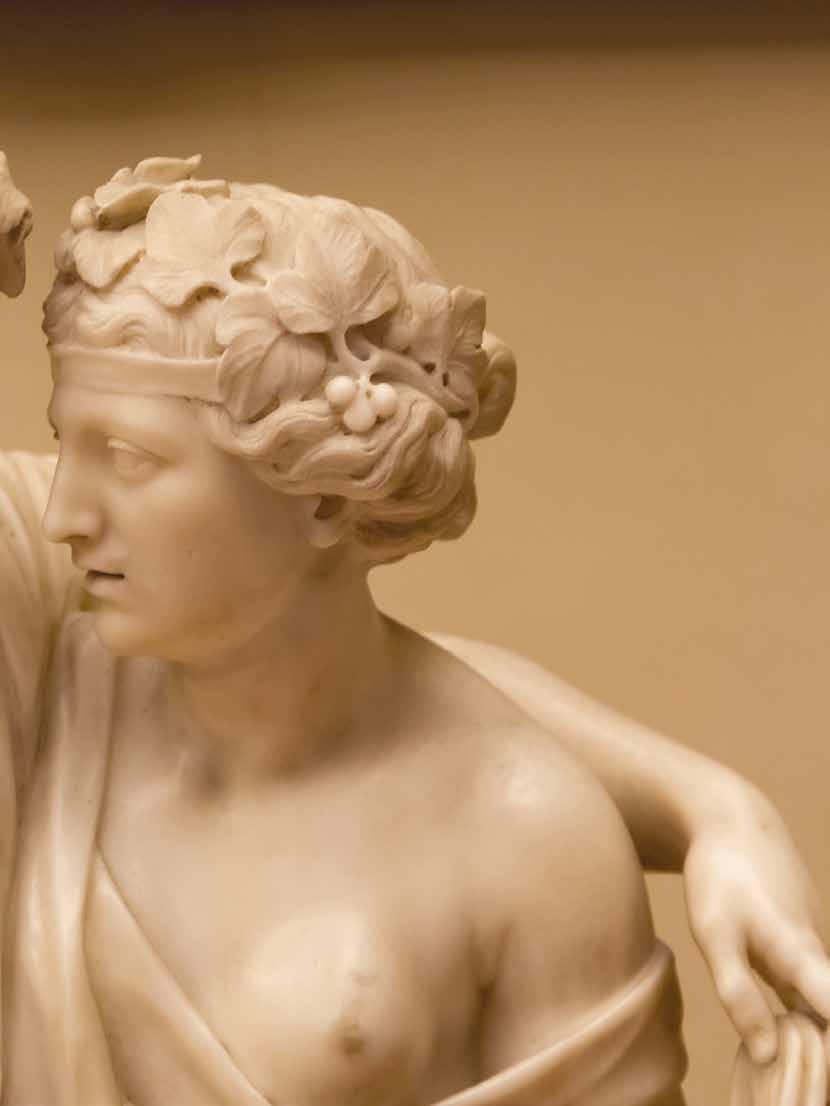
Francesco Carradori (1777). Ariadne, daughter of King Minos and Pasiphae, in the arms of her husband, the god Dionysus or Bacchus, in the work of the Italian sculptor Francesco Carradori (1777).

Jatta, Ruvo di Puglia,
Attic red-figure krater depicting the death of Talos (Jatta National Archaeological Museum, Ruvo di Puglia, Bari, Italy).
Female deities and creatures from the depths of legend, immortals who surrender to their passions or mortals endowed with special graces and worshipped as goddesses, are all inextricably linked to Crete. The primordial need of the islanders to interpret the world around them and explain the various phenomena that aroused their curiosity, the age-old anxiety about life and death, combined with their inexhaustible imagination and their relationship with their distant ancestors, led to the creation of impressive myths that even today stimulate interest and arouse admiration.
“Crete, as the basic matrix of fiction, gives birth to a variety of myths, many of which revolve around women and their world” writes Georgios I. Panagiotakis in his book “Woman of Crete - Yesterday and Today” and continues: “In these theogonic myths, as well as in subsequent periods that unfold in the historical foreground, detached from the mythological fabric, we see that mythology is inspired by women and reserves a special place for them”. .
Besides, the very name of the island is shrouded in myth. So, who gave Crete its name? Was she the daughter of the Hesperides, the nymphs who guarded the golden apples or daughter of the first king of the island, Asterion or Asterios, who later married the legendary Minos? Another version has her as the wife of the god Helios himself (the god who personifies the Sun) and mother of


Nicolas Sanson (1600-1667). Map of Crete by the French cartographer Nicolas Sanson (1600-1667).
Pasiphae (who later gave birth to Minotaur), while yet another has her as the daughter of one of the legendary Curetes, the protectors of god Zeus as an infant. There is also another version that gives her “flesh and bones” in the famous vessel depicting the death of Talos, the iconic bronze giant who protected the island from invaders, as a female figure in an elaborately decorated pleated tunic.
Rhea’s parents, Uranus and Gaia, seem to have told their daughter in anguish, “Run for your life and, above all, save your son”. And she desperately fled to Crete (to Ida or Dikti) to escape the ravenous Cronus, her husband, who had by then devoured five of his children so that Gaia’s prophecy that he would lose his dominion to one of his children would not be fulfilled. Cleverly, Rhea, once she gave birth to Zeus -who later became the supreme of all gods- tricked Cronus by giving him a rock wrapped in swaddling clothes. Sheltered from the threat of his father, the divine baby was raised in the Idaio Andro, the cave of Ida, on the nourishing milk of the goat Amalthea (it’s no coincidence her horn is synonymous with abundance). His
education had been entrusted to three women, the nymphs Amalthea, Ida and Adrasteia, and his protection to the giant Curetes, who clanged their armour loudly to cover the cries of little Zeus -so that Cronus would never realise that he had been tricked by his wife.
Carefree Europa, the beautiful daughter of the kings of Phoenicia, Agenor and Tilephasa, was picking flowers with her friends on a beach, oblivious to the fate that awaited her. Zeus, notorious for his passionate crushes, saw her there and decided to claim her for himself. To trick her, he transformed himself into a majestic white bull, who enchanted her with his serenity and rare beauty, and she rushed to caress him. Once she mounted his back, the Zeus-bull immediately shot forth according to Moschus of Syracuse (2nd century BC) and galloped forward over the waves, while the sea calmed beneath his feet, the whales frolicked around him, the dolphins leaped in the waves, the Nereids followed him, and the Tritons played the wedding tune with their long shells. Their final destination: Crete.
According to different versions of the myth, the “unlikely” couple eventually mated either in Diktaio Andro or in Gortyna, Crete, under a plane tree (which has since become evergreen). Three children were the fruit of this divine union, Minos, Rhadamanthus and Sarpedon. And the first-born son of Europa, whom Zeus later gave in marriage to the king of Crete, Asterion, was destined himself to become king of Crete -and to lend his name to the Minoan civilisation, one of the most important in human history. It is no coincidence that this legendary woman, Europa, was considered by others to be
The god Dionysus and Ariadne as depicted on a 3rd century BC sarcophagus (Rome, Italy).


The sculpture “Horn of Amalthea”, work by the Sotiriadis brothers (2000), in the harbour of Agios Nikolaos in Crete.
one of the Oceanids; gave her name to our continent; was honoured after her death as a goddess under the name of Elotia; and her worship spread to the rest of Greece, while the myth of her abduction inspired countless writers and artists from antiquity to the present day. The same myth, according to Lucian of Samosata (2nd century AD), was engraved on the currency of the inhabitants of Sidon (then a Phoenician city, now the third largest city in Lebanon), while Europa and the bull are depicted on the Greek two-euro coin.
An immortal would be the most fitting match for King Minos. And she was none other than Pasiphae, daughter of Helios and the Oceanis Perseid. According to legend, Poseidon gave Minos a white bull to sacrifice on the altar of the sea god. However, dazzled by the beauty of the animal, he sacrificed another bull in its place. Enraged by this disrespectful behaviour, Poseidon devised a fiendish plan: he instilled in Pasiphae an unnatural love for the bull, and she, surrendering to her unfulfilled desire, asked the craftsman Daedalus to make a wooden hollow model of a cow, in which she hid. According to another version, Pasiphae, disgusted by her royal husband’s constant infidelities, decided to avenge him through her erotic union with the handsome bull. She was also credited with knowledge of ancient magic -like her sister Circe, the sorceress who turned Ulysses’ companions into pigs with her magic wand, and her niece Medea, who killed her own children to avenge her husband Jason. As a sorceress, Pasiphae is said by Apollodorus to have eliminated all of Minos’ potential concubines by turning his semen into a deadly substance from which snakes, scorpions and other terrifying reptiles emerged. The queen was eventually united with the bull in the form of a cow
and thus was born the fearsome Minotaur, an otherworldly monster with the head of a bull and the body of a man. Did Pasiphae ever love the Minotaur? According to Euripides’ tragedy “The Cretans”, of which only a few extracts have survived, when Minos is informed of the newborn’s strange form, we learn that Pasiphae nurses him like a normal baby.
The king, however, sunk in shame, made the Minotaur disappear from the face of the earth: he locked him in the legendary underground Labyrinth, with its meandering tunnels. Feeding only on human flesh, every nine years it devoured seven young men and seven young women sent by the Athenians -the heavy blood toll they paid to Minos for the death of his son Androgeus at the Panathenaea. As for Pasiphae, her name was associated with the goddess Artemis, but also with Crete herself, who gave her name to the island, while according to the traveller Pausanias, the ancient Thalames of Messinia had a bronze statue of her next to the statue of the god Helios, as well as a dream oracle dedicated to Ino-Pasiphae, in which the priests fell into a deep sleep before giving out prophesies to the believers.
The daughter of Minos and Pasiphae was destined to abandon her parents, betray her country, cause the death of her half-brother and become the object of desire for two men: a mortal hero and a god. When the legendary Theseus, son of Aegeus, king of Athens, arrived in Crete with the young men and women of Athens who were about to give themselves over to the appetites of the Minotaur, Ariadne fell madly in love with him. In order to help him not to get lost in the Labyrinth, she gave him a ball of yarn (the famous “Ariadne’s thread”) that he could unravel to find his way back to freedom. The Minotaur was killed, the Athenians were saved, Theseus burned the Minoan ships so they wouldn’t follow him, and when he left he took the king’s daughter Ariadne with him. However, when they stopped at Naxos, the god Dionysus (or the goddess Athena) came to him in his sleep and ordered him to leave Ariadne on the island and return to Athens. Which he did. As for Ariadne, however distraught she was by his betrayal, she was fortunate in her misfortune. The god Dionysus promised her eternal love and devotion, offering her sweet wine and a golden luminous wreath, the work of Hephaestus himself. Ariadne remained faithful to her god-husband, even when they were later defeated at Argos by the goddess Hera and Perseus -and Ariadne was turned to marble by Medusa’s terrible gaze and became a bright constellation in the sky.



Polco Sailing is an award winning cruise and private charter company established in 1985, and based on the island of Milos, in the beautiful Cyclades. We specialize in daily sailing trips around Milos and the neighbouring islands of Kimolos & Poliegos, and we also organize private and multi-day charters.
Our team of friendly, professional skippers operate a fleet of two catamarans, three monohull sailing boats and a 9.3-meter motorboat/rib. Our aim is to provide high quality and personalized services.
• Milos and Poliegos cruise; sail around Milos, see the island highlights and visit the fantastic Blue Lagoon in Poliegos
• West Milos and Kleftiko cruise; a slower paced cruise focusing on Kleftiko and the cave of Sykia, the biggest cave in Milos Kimolos and Poliegos in small groups
• Private daily cruises with catamarans or sailing boats; avoid crowds and live an amazing day at sea with your loved ones.
• Half or full day motorboat cruises; If you are short on time, rent our motor boat with our skipper and see the best of Milos in 4 hours.
• Special events organization (birthday parties, wedding anniversaries or proposals, photo-shoots)
• Snorkelling & cave exploration tours

• Small groups
• Friendly, experienced crew
• Variety of itineraries & boat types
• Underwater photography
• Fresh, homemade food & drinks throughout the day Adamas www.polco-sailing.com info@polco-sailing.com
facebook: Polco Sailing Cruises in Milos
Instagram: polco_sailing
Mobile: +30 6978 248217


AS WELL AS BEING AN ENCHANTING HOLIDAY DESTINATION, MILOS IS AN OPEN-AIR GEOLOGICAL MUSEUM WHERE ALL SORTS OF PRECIOUS MINERALS ARE MINED AND EXPORTED AROUND THE WORLD.
MHi los is a dreamy island with stunning beaches, but also with a mineral wealth that the whole country can be proud of. The Milos Mining Museum in Adamas is a good place to learn about this wealth, while all over the island you can see impressive rocks that owe their exotic appearance to all kinds of minerals.
The Milos Mining Museum (MMM) is a civil non-profit company, founded by Silver & Baryte Ores Mining Co. S.A. (S&B), which was acquired in 2014 by Imerys Industrial Minerals Greece S.A. Anna Vogli, a member of the Museum’s Management Committee, gave us a “tour” of the Museum’s history and the island’s wealth. The main purpose of the MMM is to record the memory and tell the story of the creation of the island itself, as reflected in its unique and varied geological history. In addition, through its exhibits, it presents the human societies that lived on the island thanks to the exploitation of stone and left their mark on ancient civilisation, navigation and trade, while providing information on the infinite uses of minerals in our daily lives, many of which are mined in Milos.

Obsidian Wing, at Milos Mining Museum.

νονται
Μετά
Samples of minerals, rocks, and fossils from Milos and other regions of Greece, at Milos Mining Museum.
After liberation from the Ottomans in 1821, the Greek state sought to organise itself and develop its mineral wealth. Since 1862, when Vasilios Melas was granted the first official licence for the exploitation of sulphur at Paliorema, the mineral wealth of Milos has changed hands many times and experienced many adventures. An important moment was 1893, when the first mining map of Milos was published, followed much later by the geological map of 1924. The most important milestone in this history was in 1899, when the exploitation of kaolin was intensified and later, in 1925, when the Klonaridis plant was built, which was renovated in 2000 by Kate Kyriakopoulou and since then has been operated by ORYMIL S.A. as the Milos Conference Centre - “Georgios Iliopoulos”. The mining of barite at Voudia commences in 1934.




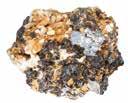





From top line left: Obsidian, andesite, kaolin, sulphur, manganese, pozzolan, baryte, perlite, bentonite
Right: Leaf-shaped spearhead at Milos Mining Museum.

The main mining company operating on the island today is Imerys Industrial Minerals Greece S.A., which exploits the large deposits of perlite and bentonite and is the world leader in their production and export. Stylianos Koufos, Procurement Manager Milos Hub, Performance Minerals EMEA, explained more about the island’s minerals and ores.
Obsidian: Obsidian is a volcanic rock with a glassy texture, formed by the rapid cooling of acidic silica-rich magma. Due to its durability, it has been used to make sharp blades since ancient times. The MMM presents the “sources” of obsidian in the Mediterranean and the Aegean in prehistoric times, and records the trade routes used for its distribution.
Andesite: The volcanic rock found in various places on Milos, due to its hardness and porous composition, it has been used since ancient times for the construction of millstones, for grinding grain and other materials.
Kaolin: It is a rock consisting of a mixture of silicon oxides of aluminium and includes mainly the minerals kaolinite, halloysite and allophane. Theophrastus and Dioscorides mention that the kaolin of Milos (Milia Earth) was widely used for painting in ancient times. It is known to have been used at least since the Neolithic Age for clay vessels, figurines, oil lamps and house coatings in Milos and elsewhere.
Sulphur: The first reference to the use of sulphur in ancient times comes from Homer in the “Iliad” and the “Odyssey”. Its therapeutic and disinfectant properties have been known since the time of Hippocrates, while it has also been used to polish metals. Sulphur is mainly used in the production of fertilisers, pesticides, paints, explosives, matches and fireworks. It is also used in metallurgy to treat iron and other metals, and in the textile industry. The systematic exploitation of sulphur began in 1862 at Paliorema in Milos, but was stopped in 1958 when a more economical method of producing sulphur was found, which is still used today.
Manganese: Manganese has been used as a pigment in painting since ancient times, along with the other ochres. It may have been “unwittingly” used with iron in iron ore metallurgy, as manganese is present in most iron ores. Manganese as an element does not exist alone in nature, but is present in various minerals during their formation, such as manganite, rhodonite and especially pyrolusite. Manganese, either as an element or as an oxide, is used in iron metallurgy, steelmaking and battery production. It is also used in the glass industry to make violet coloured glass, but also to clean (“wash”) coloured glass frit, hence the name pyrolusite -“to wash in fire” in ancient times. In Milos, the exploitation of the manganese

deposits in Vani began with optimism, but was finally stopped in 1928 due to the global recession.
Pozzolan: The presence of pozzolan (Theran Earth) in the hydraulic mortars of the ancient silver ore pans at Lavrio, especially during the Classical period, leads to the conclusion that its use has been known since antiquity. Strabo, in his “Geographica”, mentions the use of Theran Earth in Italy, while there is evidence that it has been used in mortars since Roman times. The properties of pozzolan were discovered by the Romans in a village near Vesuvius, Pozzoli, hence the name. Today, pozzolanic materials are mainly used for the production of cements with pozzolan (up to 20%) and pozzolanic cements (20-48%). Pozzolans are abundant in volcanic areas. In Greece, large quantities are found in Milos (Xylokeratia), but also in Kimolos, Aspronisi, Gyali and of course Thera (hence the name Theran Earth).
Baryte: Baryte is a mineral consisting of barium sulphate. However, the name Barytine is used in Greek mining to refer to the silver-
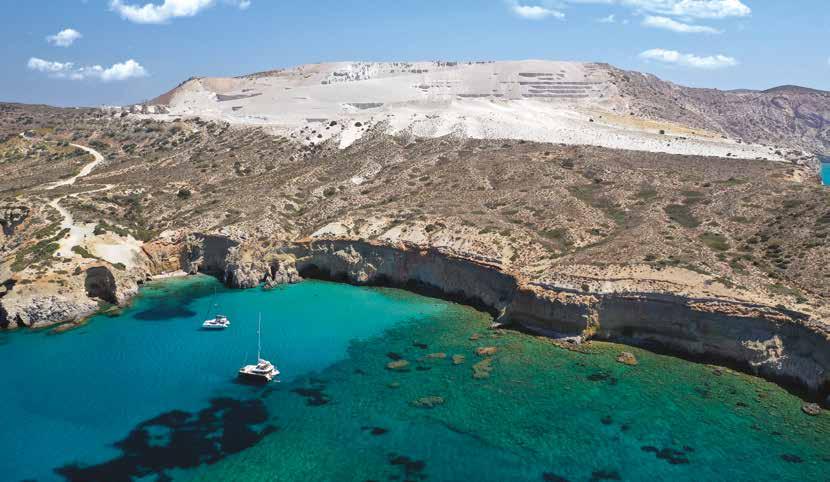

• A house needs 150 tonnes of industrial minerals in cement, plaster, glass, paint, etc., and hundreds of tonnes of ore for its metal parts?
• A car needs 150 kg of industrial minerals for its windows, tyres and plastic parts?
• A car needs 1 tonne of metals such as aluminium, iron and nickel for the rest of its components?
• Each kilometre of motorway requires 30,000 tonnes of minerals?
(πρώην S&B),
Installations of Imerys Industrial Minerals Greece S.A. (former S&B), Voudia, Milos.
poor ore of silver baryte. Baryte is mainly used in oil drilling, as well as in the glass industry, the tyre industry, the paper industry, the manufacture of paints, flares, fireworks, and as an aggregate in heavy cements. It is used in medicine as a solution administered to patients undergoing X-rays and in nuclear reactors as a radiation shield.
Perlite: Perlite is a glassy volcanic rock with a high silica content (70-76%) and 2-6% water of crystallization. Its ability to swell when heated is also due to its high water content, as the steam produced is trapped between the grains in the form of glass bubbles, resulting in a significant increase in volume of up to 20 times. Expanded perlite is used as a thermal and acoustic insulation material in construction, in lightweight concrete, in plasters, as a substrate for hydroponic crops and as a soil conditioner, as well as in pet litter. It is also used as an additive in drilling slurries and as an abrasive in detergents, soaps and polishing products. It is also widely used as an intermediate filter to separate liquids from solids (beer, wine, sugar, water, oil). Perlite is mined in Milos and exported to many countries around the world. Greece is the world leader in perlite production. Perlite is also mined in Gyali, but is found on the islands of Kos, Lesvos and Antiparos.
Bentonite: Bentonite is a rock composed of phyllosilicate minerals, mainly montmorillonite. Its main use is in foundries as a mould coating for precision casting and in iron production as a binder in the pelletisation of iron ore. It is also used in waterproofing cement injections, sanitary landfill coatings, pond/dam sealing, fertiliser/ pesticides, pet litter, ceramics, pharmaceuticals, cosmetics, photocopy paper. It is also very useful for purifying liquids (wine, juices, oil) from unwanted proteins and other substances. Milos is the main producer of bentonite, with large mining and export activities. Greece ranks first in bentonite production in the EU and second in the world. Bentonite is also found on the islands of Kimolos, Lesvos and Chios.

WE SET SAIL WITH OUR BELOVED ACTRESS KATERINA LEHOU TO EXPLORE ROLES, PLACES AND FAVOURITE SUMMER HABITS.
DIMITRIS PAPADOPOULOS
ANDREAS SIMOPOULOS Styling:
Morfe
Editor: Sophia Tsakiri, Makeup-hair: Morfe
All heads turn to take a look at her. It’s not just her beauty, it’s her energy that makes people want to talk to her. She keeps a low profile and leads a grounded life. She loves her work without letting it define her. Comedies and dramas, Ibsen, Coward and Greek authors, established and emerging directors. Damiani in “The Witch” and Eleni in the TV series “Happy Together”, but also a presence in “The Island”. “Personality matters most in this job. More than talent. A good personality is team-oriented, has the will to learn and grow” she says in an interview. Her personality illuminates her talent. She is a giving person with open arms, a confirmed good friend, who offers unconditional love and support to her colleagues.
Which is your favourite island?
The next one I’ll visit! My husband, Manos Stratakis, when he finds a holiday destination he likes, he wants us to go there again and again, but I tell him, “It won’t work with me”. We have so many beautiful islands, why should we always visit the same one? Every island has its own charm. Our islands are endless and unique.



You spent some time in Crete filming the TV series “The Island”. That’s right. We stayed in Plaka and didn’t move much. It was winter and we stayed in a hotel that had been opened especially for us. There was a tavern too, which also worked for us around the clock, with catering for lunch and dinner. We stayed for quite a while -I stayed for about nine months. It was a very authentic experience.
With great pleasure. Besides, as I always say, the road has so many virtues. You concentrate on your work, all your energy goes into it, you connect with people and that’s how you perform better.
Do you work in the summer?
I haven’t worked for many, many summers. I avoid tours. Of course, I happened to be filming and spending the whole summer in Athens. I also worked at the theatre in Athens, at Alsos, Park, Hellenic Cosmos... But this touring thing, where you’re on a bus all morning, in some random hotel in the afternoon and playing in the middle of nowhere at night; I can’t do it anymore. I would only like it if I had one day to travel and one day to play so that we could rehearse.
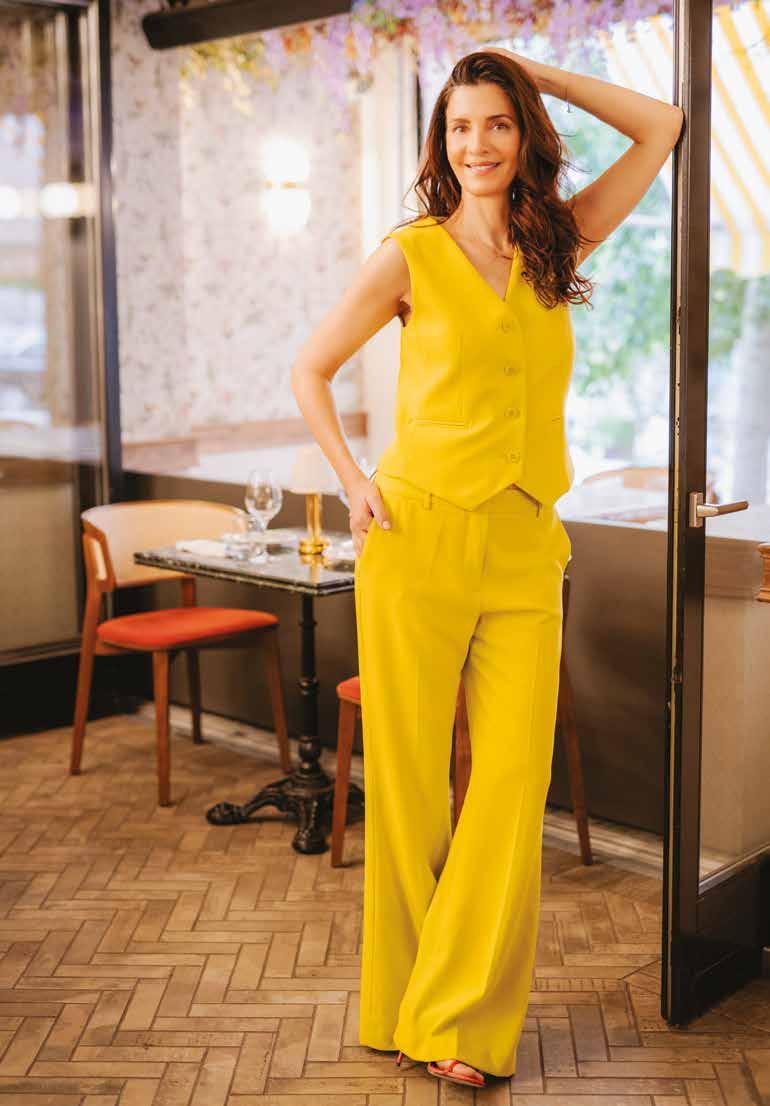
Is it also about the repertoire?
No. Just, generally, it is not easy and I for one do not enjoy it very much. The sun is bad for the voice, it makes it weary. Just like the humidity and the sleepless nights. I don’t like sitting in a room and going out just to play.
How is your ideal summer?
I like the city too, especially in August in Athens. This year, for the first time, we will be able to go on holiday for 10 days in June and I am very happy about it. June holidays are different -the weather, the sea, the people...
It was a long winter for you, wasn’t it?
It’s been almost two long winters -the first one sort of stretched into the second. “The Witch” is over for all of us who played in it, because what happens next refers to a time before that, 100 years ago. Next year I will only be doing theatre and rehearsals will start in the summer.
Have you ever spent a summer holiday abroad?
No, I wouldn’t want to go abroad for the summer. I need the sea and the peace it brings. The Cycladic islands in particular have a calming effect on me. I like them because they are not very green. I get agitated by the green; the stone and the sun calm me down.
Do you like the winter?
I don’t think there is winter anymore, but in general, as a Mediterranean person, the cold makes me feel a bit uncomfortable. I think it’s the rain that bothers me the most. The fact that we didn’t have a winter this year is certainly a nightmare scenario for the future. I worry about the kind of world we are leaving for future generations. Today the deserts are already flooding, everything is falling apart, it’s a crazy state of things, and yet some people still question that there is climate change and that this is happening.
Is it still up to us to reverse it?
Scientists say -and I believe it as well- that there is still a chance, if those in power take some serious decisions, that this climate change will not progress. On the other hand, on my side, I do everything I can, from what and how much I eat to not littering left and right.
What are the essentials you always take to the beach?
Sunscreen and a hat are a must. But most of the time I try to stay in some place that is right on the beach and sit on the terrace or be in the sea. I don’t like sitting on the beach.
June holidays are different -the weather, the sea, the people...
Childhood summer memories?
In Ntamouchari, in Pelion, without electricity, without access by car -only by boat from Ai-Giannis or by donkey from Mouresi- and to use the telephone we had to go at the grocery store. We used to go there all summer and it was a dream. Sea and play all day long. We invented games -I directed my first plays there.
Would you like to direct something in the future?
I don’t overestimate my powers, it’s not my burning passion and I’m generally a bit of a coward. I don’t dare to do things. I could have done a lot more had I dared. On the other hand, this is not my chosen profession. I see colleagues who do it very nicely, like Papaspiliopoulos or Markoulakis. But these people I mentioned are different people -I think they’ve always had that flame.
Do you have any repressed feelings about your job? Something you’d really like to do?
No, not at all. Everyone has their own personal journey. Everyone is unique. What I want is to do what I do in the best possible way. You have to move things around a bit and they move you around a bit -life is unpredictable in general and especially in our line of work. You choose, but it’s also what they propose to you most of the time.
Do you plan your next moves?
I don’t plan anything anymore, but I didn’t do it systematically before. I am sensitive to my needs, but also open to the unpredictable. When “The Witch” ended this year, before the phone started ringing, I sat by myself and wondered what I wanted
Zara, zara.com
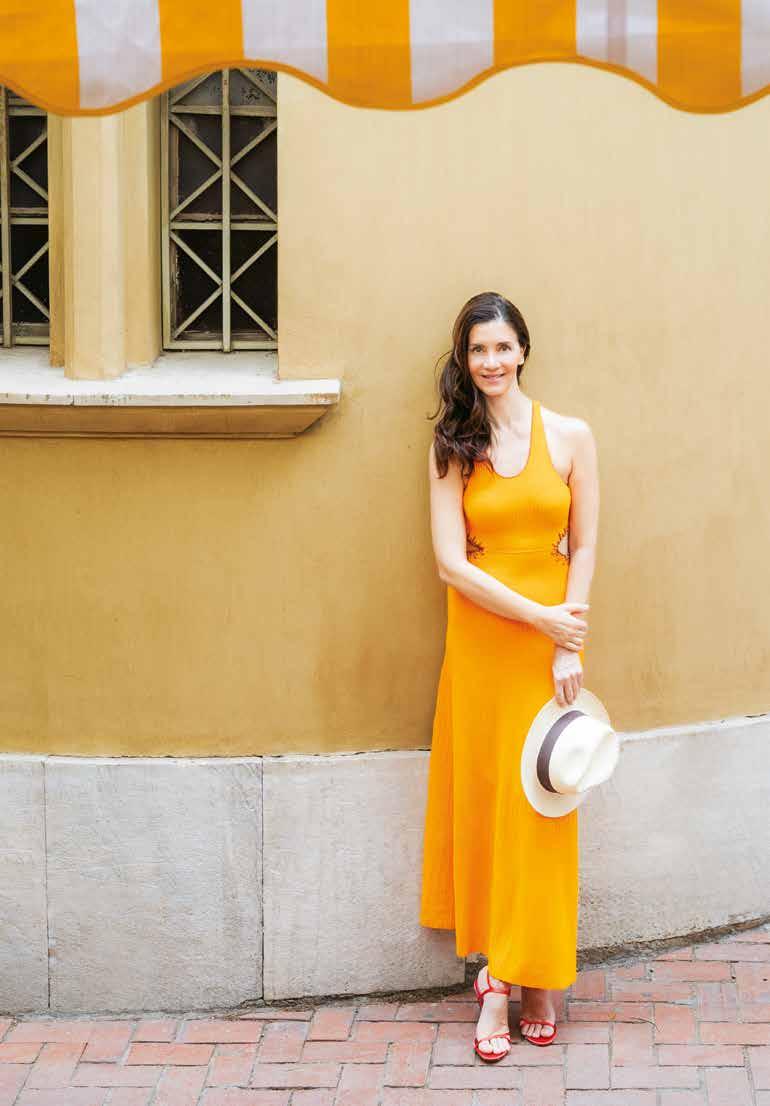

to do next. I thought I wanted to do theatre and then the offer came and it clicked.
Did you take your time with your thoughts and decisions from an early age?
Yes, I didn’t stress out, I didn’t worry if the phone would ring for work, I wasn’t even sure if it would. I could see things were going to happen, but I had to be ready. Therefore I always had work to do. Because to be ready, both at work and in life, you must never stand still -in the sense of never being idle. So I try to take care of my mind, my body, keep up to date, learn as much as I can, be alert and if something comes up I think I’ll be able to fit in.
Is this preparation a personal undertaking or does it involve discussion with your husband or other colleagues?
It is an internal and personal process. For me, at least, it has to do with my personal needs. Of course I will share something with the person I live with, but we have to give each other space to feel free.
When you’re not working, what’s your daily life like in Athens?
I’m a homebody. I spend a lot of hours at home and never get bored. My home is my castle. I generally read, exercise, watch something I like, listen to my music, cook.
Have you ever been on holiday on an island you’ve visited before and you don’t recognise anymore?
Yes, unfortunately. It has happened to me with Mykonos, which I visited 15 years ago. The second time round, I found it was as if everything had become confused, unified, and I couldn’t understand where I was. I really wanted to leave immediately, the place was completely unrecognisable and alien to me. The other place where something similar happened to me is in Ntamouchari. I hadn’t been there since I was 11. Fortunately, it had not been maltreated, but it lacked the primitive and authentic element that had impressed itself on my memory in the first decade of my life. I understand that people’s habits and demands are changing, so all these places are trying to cater for that. It would just be better if it was done with a little more respect for nature and the specific characteristics of each place. Because if these are completely circumvented, the place is violated and turns ugly.
We would like to thank the management of the Gloria Gati Restaurant (6 Agiou Georgiou Street, Karytsi Square, Athens) for their kind hospitality. gloriagati.com



DELICIOUS TRADITIONAL DISHES FROM CRETE, MADE WITH LOVE AND TRULY LOCAL INGREDIENTS, DRESSED WITH THE PUREST OLIVE OIL, ARE THE IDEAL “SPOT” FOR A DIFFERENT KIND OF DIP WITH FRESHLY BAKED BREAD OR CRUNCHY RUSKS.

BY MARIA ATMATZIDOU
The cradle of the mighty Minoan civilisation, and a crossroads for peoples and cultures over the centuries, Greece’s largest island is home to numerous archaeological sites, finds and monuments that bear irrefutable witness to a glorious past. Combined with its unspoilt natural beauty, endless beaches with crystal clear turquoise waters,

είναι
caves and gorges, Crete is sure to attract travellers with a wide range of interests from all over the world. But if there is one thing everyone can agree on, it is the deliciousness of its traditional dishes.

Moreover, the traditional cuisine of Crete, “the product of a cumulative experience that has allowed the flavours, the smells and even the names of Cretan dishes to travel through time unchanged for centuries... is based on simple techniques and original combinations...” writes Myrsini Lambraki in her book “Cretan Cuisine” (Myrsini’s Editions).
Dishes with history
Cretan cuisine offers a priceless culinary treasure with recipes from the Minoan era -5,000 years ago- and high quality local produce. “... in the case of Crete, there are several findings proving that the Traditional Cretan Diet, which existed on the island until the middle of the 20th century and which, fortunately, is still preserved today in several households in the Cretan


countryside, seems to have its roots in prehistoric and Minoan Crete” writes Dr Anaya Sarpaki, archaeologistarchaeobotanist, in her book “Traditional Cretan Diet - Its Minoan Origins and Evolution” (Association of Cretan Olive Municipalities - ACOM): “During the Minoan period, oil seems to have been widely consumed, as large jars for storing olive oil have been found in most areas of the island, while the Linear B script largely refers to the use of olive oil in many cases and not only for food”.
From prehistoric and Minoan times through the Byzantium, the Venetian and Ottoman rule, and then the arrival of refugees who fled to Crete from Asia Minor, the traditional cuisine has been influenced by many factors, all of which have been masterfully integrated. Yet, it has managed to maintain its authenticity over the centuries with a rich “repertoire” of flavours based on what is generously offered by the Cretan land: olive oil and olives, vegetables, wild greens, legumes, fruits, aromatic herbs, grains. But also, fish and seafood, and the characteristic chochlioi -the famous snails- as well as dairy products, and meat, in smaller quantities of course. Its temperate climate, the inexhaustible richness of its land and its unique biodiversity, as well as the lifestyle of its inhabitants, have given rise to a type of food that is recognised worldwide not only for its simplicity and imagination, but also for its benefits to health, well-being and longevity.
WAVE


Βουτήξτε


The journey to the delicious Cretan flavours starts before you even set foot on the island! The renowned chef Nektaria Kokkinaki, inspired by her roots, has created a menu as an ode to the Minoan land, to be served in the restaurants of FESTOS PALACE and

Any kind of stew is ideal for your... dips; as is any casserole. Try hare or rabbit stew, with lots of onions and delicious ripe tomato and wine broth, scented with spices, cloves, cinnamon and bay leaves. Besides, the Minoans hunted hares and rabbits, but also wild goats. Aubergine casserole with feta cheese is a heavenly dream; chickpea casserole with the reddish sauce in which they are cooked; Heraklion casserole with all kinds of vegetables from the Cretan allotment -green beans, courgettes, potatoes, okra and aubergines; and also, parsley casserole with freshly chopped parsley and tomatoes to spread on your bread. The scents of the sea come to your table and combine with the richness of the Cretan land when you taste the fish and squid cooked with leeks and fennel, the octopus with wild greens, but also the squid with its ink that smells of a Cretan wine reduction sauce. There are many delicious dishes cooked in the Cretan pot, such as the beloved eggplants simmered with tomatoes, onions and garlic, or the popular briam with courgettes, tomatoes and onions. And if you like, add feta cheese, kefalotyri or xinomizithra to heighten the senses. And even though meat was not really included in the Cretan quiver of taste, when combined with the wild edible plants of the Cretan land, it turns into a gastronomic poem. Take, for example, the characteristic stamnagathi, which leaves a slight bitterness in the
KNOSSOS PALACE ships of the MINOAN LINES. The twelve traditional recipes, using fresh ingredients from local producers and bearing the “Quality Label of Cretan Cuisine” by the Region of Crete, are the ideal first contact with the local cuisine before you set off to discover all the delights of the island!



mouth, wild and authentic, like the unspoilt nature of the island. Try goat and stamnagathi and dip your bread in the rich, warm sauce that smells of pure olive oil, wine and lemon. Or try it with lamb fricassee. Or even with golden thistle and lamb with avgolemono (egg and lemon sauce) and dip your bread in the aromatic sauce. The famous staka may not be the most representative of the Cretan diet of the 1960s -which was the basis of the Mediterranean Diet, recognised by UNESCO as Intangible Cultural Heritage since 2010- but as we are in Crete, it would be a shame not to try this delicacy! Especially when we can taste the fresh eggs, boiled in hot water and then covered with the thick staka cream. Salads and fresh vegetables are equally delicious, the perfect accompaniment to your bread and rusks. The Cretan salad, a variation of the Greek salad, with Cretan rusk or barley dry bread, boiled potatoes, spring onions and capers, purslane and boiled eggs, and of course white cheese, mizithra or feta, with plenty of olive oil and oregano dressing, brings the freshest and most distinctive flavours to your plate. Be sure to also try the fragrant samphire, with oil and lemon, and the golden thistle, which can be a unique accompaniment to meat, but when boiled and served


with a rich olive oil and lemon dressing, they are magic. Equally unique are the tassel hyacinth bulbs, fragrant, dipped in oil and flavoured with spearmint or “avarsamo”.
And as for perhaps the most representative dish of Crete, I saved that for last. Cretan chochlioi, the amazing superfood, was one of the most popular dishes of the Minoans. Cretan superfood in all its glory! They are low in calories and high in nutritional value (source of iron, protein, vitamins and minerals). Try the “chochlioi boubouristi”, fragrant with thyme, oregano and “arismari” (rosemary), with a hot sauce from the pan, but also simmered with fennel.
Cretan tables are rich with what nature generously offers, combined with the skill and passion of the islanders. Just a little bit of Cretan oil -although oil has been abundant in Crete since ancient times, according to the travellers of the time who observed that all food was soaked in oil- along with a few olives, some sourdough bread to dip in and a mellow local wine (or a cool raki); well, even this is enough! Or perhaps, it’s the most ideal. Besides, this was the wonderful trinity of the most valuable products of the Cretan land: wheat, oil and wine. What more could you ask for?




CAVES, GORGES AND GULFS, UNDENIABLE AMBASSADORS OF CRETE’S NATURAL BEAUTY AND INEXTRICABLY LINKED TO ITS HISTORY, OFFER THE CURIOUS VISITOR COUNTLESS OPPORTUNITIES TO DISCOVER YET ANOTHER, EQUALLY CHARMING SIDE OF GREECE’S LARGEST ISLAND.
ΒY MARIA ATMATZIDOU



Diktaion Andron or Psychro Cave..
A Bonelli’s eagle perched on a tree branch just before it flies over the gorges of Crete.
From one end of Crete to the other, the caves and gorges, shrouded in the mists of myth, are renowned for their unspoilt natural beauty. As well as the endless beaches, traditional settlements and cosmopolitan centres, there is also the other side of the island, an attraction for nature and adventure lovers, where caving (exploring caves) and canyoning (crossing gorges with special technical equipment) offer another dimension for those who wish to discover it.
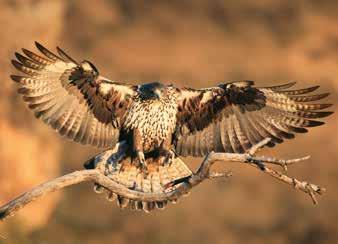
“The composition of the rocks of Crete and its tectonic structure enable the underground and surface waters to create many and varied karstic landforms (caves, gulfs, sinkholes, dolines, poljes, gorges, etc.) especially in the limestone rocks” writes Andonis Vasilakes in his book “Minoan Crete: From Myth to History” Adam Editions): “Crete has rightly been called the «land of caves and gorges» with 3,500 documented caves and other karst landforms. Many of the caves and cave gorges have remarkable natural patterns, great flora and fauna and play an important part in the mythology, history and culture of Crete”.
Shelters at first, then sacred burial sites and famous places of worship, the hidden treasures of this inexhaustible natural landscape have been present since prehistoric times -just look at the rock paintings (petroglyphs) depicting deer, antelopes and ships from different eras in the Cave of Asfendos in Sfakia.
Or the Eileithyia Cave in Amnissos, Heraklion, first mentioned by Homer, which was the place of worship of the goddess inextricably linked to pregnancy, childbirth and motherhood, but also to the euphoria and regeneration of nature. According to ancient tradition, her name may have derived from the cries of women in labour, “Elthe! Elthe!” (“Come! Come!”) and their pleas for her to come to their aid.
“Many of the Cretan caves have been places of worship for many centuries and are a treasure trove for archaeological research” writes archaeologist Litsa I. Hatzifoti in her book “Minoan Crete, Between Myth and History” Toubis Editions): “In some, worship was converted and religious life continued there throughout the Christian era, and in some cases right up to the present day. There are about one hundred and twenty caves with Christian churches”.
Such as the cave of Agia Paraskevi, near the village of Skotino, Pediada, 22 km from Heraklion. This was the place of worship of the goddess Vritomartis or Diktynna, the sweet virgin, daughter of Zeus and Karmi, who became the most ancient patroness of hunters and fishermen. On the plateau above this imposing cave, with its impressive stalagmites and stalactites and the huge 37-metre-high chamber called the “Great Temple”, stands the
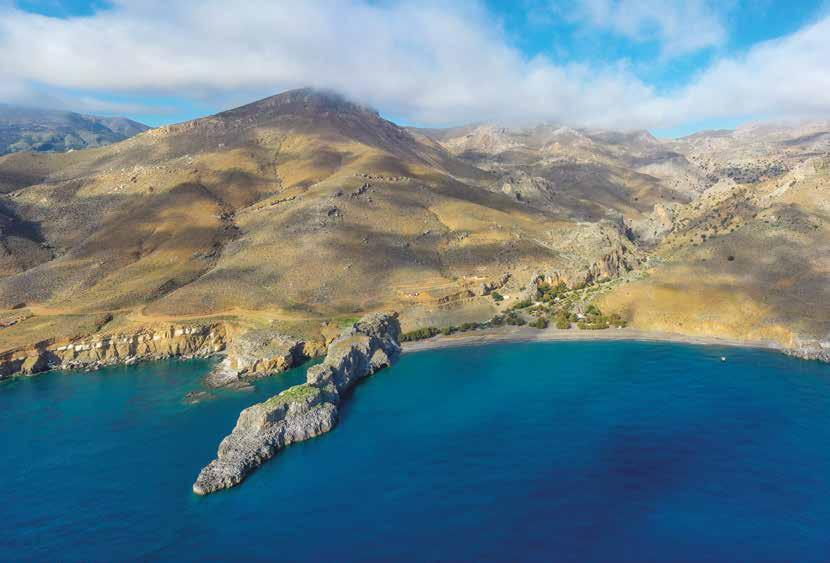
The beach of Tripiti where the homonymous gorge ends, in the Asterousia Mountains.
The Sfendoni Cave with its impressive stalactite and stalagmite decorations.

chapel of Agia Paraskevi, while once there was even a chapel inside the cave.
In the Psiloritis Natural Park, a UNESCO Geopark, about 1 km from Zoniana, Mylopotamos and 43 km from Heraklion, lies one of the most beautiful and impressive caves in Crete. Cave Zoniana, Sfendoni or Sfendoni’s Hole, impresses with its massive stalagmites that change colour, its labyrinthine chambers, its stone pools and the legends that surround it. It is said that there was once a tough rebel from Sfakia, called Sfendonis, who beat to death with his boot a boy who asked him for food (it is even said that the skeleton found inside the cave, buried centuries ago, belongs to him). Or that a beautiful fairy once lived here and the shepherds fell in love with her and hit her with their slingshots to keep her close. But she has always eluded them -and she may still be hiding somewhere in the cave.
Whether it was women asking for help from the gods, or farmers and shepherds praying for a good harvest or for the protection of their flocks, these sacred caves, along with sacred mountain peaks such as the one of Juktas, were the most suitable place for believers to come into contact with their gods. In Crete, two caves were associated with the king of the Olympian gods, Zeus, and became the most famous centres of worship.
It is said that Rhea fled to the Diktaion Andros, or Psychro Cave, on Mount Dikti in Lasithi, to give birth to Zeus safely, away from
the wrath of Cronus, who devoured his children to prevent them from taking his kingdom as had been prophesied. At an altitude of 1,025 m, it is one of the most impressive caves to visit, with magnificent stalactites and stalagmites, including the “Mantle of Zeus”, and a small lake. The numerous finds made during archaeological excavations demonstrate a continuous presence from the Neolithic to the Roman period, with a peak in the Minoan period. Many worshippers appear to have flocked to the cave to worship the deity, offering figurines, vases, double axes, gems and jewellery, arrows and knives, and other symbolic offerings.
According to other myths, it was at the Diktaion Andron (and not at Gortyna) that Zeus, as a bull, made love to Europa, whom he had kidnapped from Phoenicia, and the fruit of their love were Minos and his brothers. Perhaps that is why King Minos came here every nine years to ask his divine father for guidance on how to rule Crete with justice. Here lived the legendary Harpies, chthonic deities in the form of birds with the head of a woman, and here slept the famous seer of antiquity, Epimenides, for many years to acquire his divine wisdom.
In another part of Crete, near Anogia, Rethymno, on Mount Ida (Psiloritis) and at an altitude of 1,538 metres, there is another sacred cave, the Idaion Andros, also known as “Spiliara”. According to another version of the myth, this is where Rhea hid her son, still a baby, to be raised by the nymphs Adrasteia and Ida, with the milk of the goat Amalthea, protected by the Curetes, the demons who beat their shields and weapons, dancing with their loud footsteps, to conceal the crying of the divine baby. Reminiscent of an ancient

The Diktaion Andron, where, according to myth, Zeus was born.
temple, this imposing cave -with three chambers and the sanctuary, but also with three impressive stalactites at the entrance- seems to have been in continuous human use from the 4th millennium BC to the 5th century AD, according to archaeological excavations. It was here that worshippers came to pay homage to Cretan Zeus and other deities. This is evidenced by the ritual offerings that have come to light -idols, utensils, weapons, jewellery, coins, the impressive bronze shields from the 8th and 7th centuries BC, and the bronze drum with elaborate representations of Zeus and the Curetes, now in the Archaeological Museum of Heraklion.
For millions of years, the island’s geological relief has been constantly changing. Mountains rose, rivers flowed between them, forming bottomless gorges and steep gulfs of immense natural beauty, playful lakes and thunderous waterfalls, some known today, others inaccessible, but all sheltering unique fauna and flora.
“There are many gorges in Crete, perhaps more than 250 [...] they are mostly dry, except for certain periods of the year, such as in spring when the snow melts, or in autumn and winter after several days of rain. However, with or without water, the

The Aradaina metal bridge in the gorge of the same name at Sfakia.

Above: The protected Samaria Gorge.
Below: The endangered Cretan goat or kri-kri in a visitors’ rest area.
gorges of Crete have a special character, because they are wild and beautiful at the same time, and canyoning is an ideal way to get to know landscapes that are as untouched as they are enchanting” writes Yannis Bromirakis in his book “Canyoning in the gorges of Crete” (Road Publishing).
A trip to Crete should also include a visit to the protected National Park of Samaria. The classic route of 16 km through the gorge to the Agia Roumeli Beach is definitely one of the most memorable parts of a visit to the island! Especially as you will Επάνω:Το
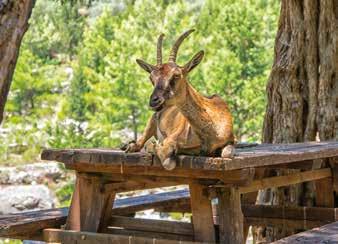

The Richtra Waterfall, in the Portela gorge, which ends in Keratokampos (Heraklion).
have the opportunity to admire the impressive biodiversity of the Cretan land, such as the endangered Cretan goat or kri-kri. On the western side of the White Mountains is the gorge of Agia Irini, with its rich vegetation of cypresses, pine trees and herbs, which has been declared a Wildlife Refuge. Now, if you want to get your adrenaline pumping, you can bungee jump from the 138-metre Aradaina metal bridge in the gorge of the same name at Sfakia -the highest bridge in Greece and the second highest in Europe. Kourtaliotiko, an impressive gorge 22 km from Rethymno, owes its name to the kourtala or krotala (rattles) and their loud sound when they ring. With its huge rocky slopes, caves, cool springs and waterfall, golden and Bonelli’s eagles soaring in the sky, and the Preveli palm forest, where the Kourtaliotis River ends, it is definitely a unique destination.
An incredible challenge, only for those with canyoning experience and with the help of local guides, is the 1.7 km Arvi Gorge in the prefecture of Heraklion. The landscape is beautiful, the running waters and waterfalls unique (such as the so-called Kapnistis [Smoker], whose water appears to “smoke” when it falls with great force), the dark point with the cave in the depths of the earth where the river falls is completely mystifying. Only the flashlights provided will cut through the darkness -something truly unique.
The Tripiti gorge, in the Asterousia Mountains, is also impressive, about 4 km long, until you reach the namesake beach. However, the first section, near the church of Agia Paraskevi, requires technical
knowledge and appropriate equipment. There is, though, the winding dirt road from the village of Vasiliki that runs parallel to the gorge, passing by the church of Agios Savvas with the wild olive trees and the narrow gorge with the “Sympligades” stones, before ending up at the sea.
South of Heraklion, between tall grey-brown rocks, lies the steep and imposing gulf of Vourvoulitis. At the bottom lies a beautiful lake with deep blue water and emerald tones, where the salt water of the sea meets the fresh water of the lake. To get there, one must first pass by the stunning beach of Agiofarango, where the homonymous gorge ends. Then there is a 10-minute climb up the rocks, and finally the descent into the gulf, which is dangerous, so you better be careful. But the dive in the crystal clear deep water is well worth it.
In Lasithi, however, is perhaps the most impressive gorge from a technical point of view, with the curious name Cha, from the word “chasm”. This 1.6 km long gorge, with vertical narrow walls up to 400 m high and a beautiful lake where the last waterfall plunges to a height of 215 m, is imposing but also challenging, fit for the most experienced and daring climbers: starting from the Chapel of Agia Anna, always with the right team and the necessary equipment, you have to reach the end because there is no escape route.

The imposing Cha Gorge, which ends at the Pachia Ammos Beach.
Did you know that…
The gorges of Crete hide some of the highest and most impressive waterfalls in Greece: the impressive Perdika (Parafarago) waterfall in the Samaria Gorge (240 m), the Mastoras waterfall, which cascades into the Cha Gorge to create a spectacular display (215 m), and the Amba waterfall in the Asterousia Mountains (145 m).


MUSEUMS, FAMOUS PAINTINGS, ARTISTIC GENIUSES, FINESSE AND MASTERPIECES KNOWN THROUGHOUT THE WORLD. NO MATTER WHICH ITALIAN CITY YOU VISIT, NO MATTER WHERE YOU LOOK, SOMETHING BEAUTIFUL AND SPECIAL AWAITS YOU.
Birth of Venus”, Uffizi Gallery Museum, Florence.
Ashort visit to Rome is enough for anyone to understand that the Eternal City holds the golden key to eternal beauty. From its squares decorated with sculptures comparable to those in museums, to a dish of pasta with white sauce that you will eat and remember for a long time, the Italian capital, like the whole of our neighbouring country, is an earthly paradise of art, culture, small everyday things, but also of unsurpassed masterpieces.
Uffizi Gallery Museum, Florence
“The Birth of Venus” (La Nascita di Venere) is one of the most famous paintings by Italian Renaissance artist Sandro Botticelli, created around 1485-1486. It is part of the collection of the Uffizi Gallery Museum in Florence, in the room dedicated to the great artist, and every year visitors from all over the world queue up to see it up close. This is one of the Florentine artist’s most beautiful aesthetic creations, inspired by the relevant myth of Ovid. It is

“Perseus with the head of Medusa”, Loggia dei Lanzi, Florence.

an allegory based on the concept of love as the generative force and starting point of everything.
“Perseus
Loggia dei Lanzi, Florence
The imposing statue that dominates Florence’s gem of a gallery was sculpted by Benvenuto Cellini between 1545 and 1554. It shows Perseus holding Medusa’s head as a trophy, while her naked body lies lifeless at his feet. The #metoo movement brought this already famous sculpture to the fore, restoring history and mythology: Medusa was not a monster, but a beautiful woman who fell out of favour with the gods and was demonised. The statue of the Italian sculptor, however, never ceases to amaze visitors to the Loggia dei Lanzi, made up of three wide arches open to the street and supported by columns with Corinthian capitals. The wide arches pleased the Florentines so much that Michelangelo even suggested that they be continued around Piazza della Signoria. It is essentially an open-air sculpture exhibition of ancient and Renaissance art, including the Medici Lions.
Rome
It is the most visited archaeological site in Italy and one of the most impressive buildings of the Roman Empire. The Flavian Amphitheatre, as it was called, is located on the south-eastern side of the Roman Forum. Construction began during the reign of Vespasian in 72 AD, continued during the reign of Titus and was completed when Domitian became emperor in 80 AD. Thousands


of Jewish prisoners, captured by Tito after the destruction of Jerusalem, worked to build it. It eventually took its name from the colossal statue of Nero that stood on the site where it was built. It could hold 55,000 spectators and its dimensions were enormous, reaching a height of 48 metres and counting 4 floors. The top floor was for women and the lower classes, while the first floor was for prominent citizens.
ή Sala del Maggior Consiglio,
Ferrari 330 P4, Μουσείο Φεράρι, Μαρανέλο. Ferrari 330 P4, Ferrari Museum, Maranello.
Ferrari Museum, Maranello Maranello is a town and municipality in the Emilia-Romagna region of northern Italy, famous as the home of Ferrari and its Formula 1 racing team. The company’s museum is also located there, just 300 metres from the factory. First opened in 1990, the Ferrari Museum covers an area of 2,500 square metres and welcomes an estimated 180,000 visitors a year. Whether or not you’re a car and F1 enthusiast, it’s well worth a visit. Αlongside the company’s cars -true feats of power and beauty- the exhibition includes unique prototypes and cars from another era that will take you back to a more romantic time, such as the magnificent 330 P4 -one of only four ever built. The Formula 1 exhibition includes various racing models, as well as photos of all the legendary Scuderia drivers and their trophies.
Venice
The Doge’s Palace (Palazzo Ducale di Venezia) is a Gothic palace in Venice. The current palace was built between 1309 and 1424 on top of an existing 9th century building. The design of the building is attributed to Filippo Calendario. Bartolomeo and

Giovanni Bon later created the monumental entrance to the building (Porta della Carta) from the side of the square, one of the most photographed and Instagrammable places in the world.
The palace was the residence of the rulers of Venice, or Doges, and contained the offices of a number of political institutions, arranged around a central courtyard.
The most spectacular hall is probably the Sala del Maggior Consiglio, originally used for legislative debates. This huge hall is ornamented with frescoes, elaborate ceiling decorations and many paintings, especially portraits of Doges. One of these is Tintoretto’s Paradise, considered to be the largest canvas painting in the world. Its dimensions are gigantic -22x9 metres!-, this masterful composition contains around 500 human figures, all rendered in exquisite detail. Most of Tintoretto’s great works were either inextricably
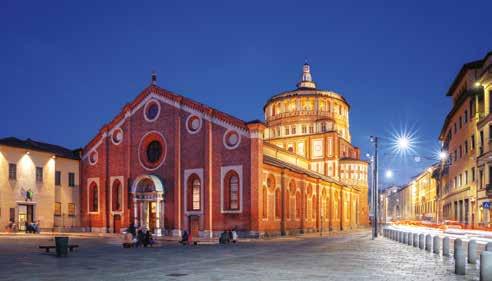

Last Supper”
Santa Maria delle Grazie, Milan.
linked to their original locations or were so large that it was impossible to move them, which is why most of them are in Venice.
Santa Maria delle Grazie, Milan
“The Last Supper” (Il Cenacolo or L’Ultima Cena) is a 15th century fresco by the ingenious Leonardo da Vinci. It is located in Milan, in the refectory of the convent of Santa Maria delle Grazie, although it was commissioned by the Duke Ludovico Sforza, who originally wanted the building to be a mausoleum for his family. It is da Vinci’s largest work and only surviving fresco, one of the most important and valuable works in the history of art, and one of the most recognisable and reproduced paintings. The value of this work has been studied not only by art historians, but also by sociologists, historians and psychiatrists, who have sought in the relationships and language of the body of the 12 Apostles and Jesus the hidden symbolism that only an artistic genius like da Vinci could leave as a legacy to humanity.

With a long history dating back to 1947, the Grimaldi Group specializes in the operation of Ro/Ro (roll-on/roll-off) vessels, car carriers and ferries. It is a dedicated supplier of integrated logistics services based on maritime transport to the world’s major vehicle manufacturers.
Through its maritime services, the Naples-based group also transports containers, palletized/unitized cargo and passengers with a modern fleet of over 130 Ro/Ro and multipurpose vessels, pure car carriers and ferries.
The Grimaldi Group offers a wide network of maritime services for passengers in the Mediterranean Sea, under the Grimaldi Lines, Minoan Lines and Trasmed brands, and in the Baltic and North Sea, through the controlled company Finnlines.
Grimaldi Lines offers maritime connections to the most popular tourist destinations in Spain, Greece, Italy (including Sicily and Sardinia) and Tunisia.
Between Greece and Italy, the company offers frequent year-round services connecting Igoumenitsa to the Italian ports of Brindisi (Apulia) and Ancona (Marche). During the summer, services between both Italian ports and Corfu are operated as well.
Aware of the need to offer ever more innovative, highquality and competitive services to its passengers, the Grimaldi Group deploys a fleet of modern cruise ferries, providing cruise ship standard facilities, and new generation state-of-the-art Ro/Ro-Passenger ferries.
The flagships of the Grimaldi Lines fleet are the Cruise

Roma and Cruise Barcelona, both deployed between Italy and Spain on the Civitavecchia-Porto Torres-Barcelona route. Despite being already the biggest cruise ferries in the Mediterranean, in 2019 they were lengthened and refurbished, which has enabled the two sister ships to transport up to 3,500 passengers. Moreover, thanks to mega lithium batteries, which are recharged during navigation, they can reduce emissions to zero while at berth.
Both vessels are equipped with 499 large, elegant cabins, 595 comfortable reclining seats, an à la carte and two selfservice restaurants, a swimming pool, a solarium bar and a modern wellness centre with sauna, hammam and massage room. On board entertainment services include a casino, a video game corner, a discotheque, a playground area for children and a 300-person conference room.
All the Group’s passenger ships perfectly combine excellent comfort on board with low-cost options. Special attention is given to families, groups of friends and students, with fare reductions offered on all routes. In addition, thematic events are periodically organised on board the Grimaldi Lines vessels mainly on the Civitavecchia-Barcelona route, while Grimaldi Lines Tour Operator offers ship and hotel packages in Greece, Spain and Italy (including Sardinia and Sicily).
The Grimaldi Group is the first Italian shipping company to have obtained the SMS, ISO 9001 and ISO 14001 certifications for Safety, Quality and Environment. Recent recognitions received by Grimaldi Lines for its outstanding performance in passenger transport include the World Travel Leaders Award (in 2016) and the Italia Travel Awards (in 2018 and 2019).




• Osteoarthritis
• Rheumatoid arthritis
• Osteonecrosis
RoHip and knee arthroplasty is surgery to replace worn or damaged joints with artificial ones. These procedures are mainly performed to relieve pain and improve joint function, especially in people with advanced arthritis or other degenerative joint disease.
Hip arthroplasty is the replacement of a worn hip with an artificial joint. This procedure is necessary when the patient has severe pain and stiffness that cannot be relieved by conservative treatments, such as medication or physiotherapy. The main indications for hip replacement surgery include:
• Post-traumatic arthritis
Knee arthroplasty, also known as total knee replacement, involves replacing the damaged parts of the knee with artificial components. This procedure is often necessary for people with severe knee arthritis who experience pain and difficulty moving. The main indications include:
• Osteoarthritis
• Rheumatoid arthritis
• Post-traumatic arthritis
Preparation for surgery includes a pre-operative examination and assessment of the patient's health. The procedure itself is performed under general or epidural anaesthesia and takes 1.30 to 2 hours. After the operation, the patient will stay in hospital for a day or two and follow a programme of physiotherapy to restore mobility and muscle strength to the limb.
Full recovery may take three to four weeks, but most patients notice a significant improvement in pain and mobility immediately after surgery.
Arthroplasty has a very high success rate and can significantly reduce pain and improve quality of life for patients. However, as with any surgery, there are risks and possible complications for which the utmost precautions are taken.
It is important that patients discuss all options with their orthopaedic surgeon and understand the benefits and risks before deciding to have a joint replacement.

OMiLEP Minimally invasive Laser Enuclation Prostate
MiLEP Minimally invasive Laser Enuclation Prostate
The revolution of minimally invasive prostate nucleation.

Men notice changes in their urination as they get older. This is due to the development of an adenoma within the prostate gland. In the vast majority of cases, it is benign tissue with no functional contribution. All it does is obstruct the free flow of urine, leading to symptoms familiar to middle-aged men such as reduced ease of urination, frequent urination, nocturia and urgency, incontinence and even inability to urinate. All these start as simple discomfort and develop into a major problem that requires medical intervention. This otherwise benign condition is responsible for a significant proportion of surgery in men over the age of 55, with considerable medical, family, professional and financial costs.
Over the years, the surgical community has progressed and continues to explore less painful and less traumatic ways to treat this benign condition. This advancement led to the complete adenoma enucleation by Holmium Laser (HoLEP).
Over the past decade, it has become the gold standard in the treatment of Benign Prostatic Hyperplasia (BPH).
• Bloodless procedure. Patients who receive anticoagulation therapy for serious reasons, where stopping would put their life at risk, can have surgery! Previously, this group had to be informed about long-term hospitalisation and be prepared for the risk of bleeding by obtaining blood for transfusion.
• A definitive solution. Complete, rather than partial, removal of the adenoma, as is the case with the widely used diuretic (TURis) procedure. No residual tissue is left to grow in the future. So the old advice given to surgical patients that they would be fine for 7 to 10 years is no longer the case. After HoLEP, men no longer have to worry about urination!
• Treats all patients. The limitations imposed by gland size on other methods do not apply to HoLEP. It treats the huge 300cc glands as well as the much smaller ones.
• Short hospitalisation. One overnight stay at the clinic.
• Rapid recovery. Within a week men have returned to their normal activities.
The endoscope has become thinner and therefore “friendlier” to the sensitive urethra, so we have:
• Avoidance of urethral trauma with rapid rehabilitation.
• Accuracy within the surgical field as we flexibly and precisely direct the powerful 150 watt laser to ensure ideal separation of normal and pathological tissue.
A common and widespread male problem is entering the MiLEP era.

Biological therapies that change the therapeutic approach.

Regenerative medicine for musculoskeletal injuries has become the “gold standard” for rapid rehabilitation and reintegration of patients into their daily activities and, most importantly, their previous capacity. At the same time, the fight against ageing requires the maintenance of vitality and high functionality of joints and muscles. Cellular therapy and tissue engineering are the main methods of regenerative medicine using autologous cells and agents to reconstruct and treat degeneration of the musculoskeletal system, its associated functions and the physical management of pain. Tailoring the treatment to each patient’s needs and eliminating the associated or coexisting problems that contribute to each pathology, combined with arthroscopic interventional techniques, gives us the ideal result!
Multipotent stem cells constitute an endogenous regeneration and repair mechanism and can “self-renew”, differentiate into other cell types, while helping to maintain cellular homeostasis and replace dead cells in the event of injury/disease.
As a scientific team, after many years of research, we have developed and published specific protocols for the production of autologous stem cells from adipose tissue or bone marrow cells. Each case is individually tailored and treated according to its needs and severity. Everything is done in a completely autologous way and follows international safety and research rules for cell therapies. Specialised post-operative rehabilitation protocols play an important role in the success of the method.
An important option in the application of biological therapies is the use of autologous PRP/PRF (Platelet Rich Plasma/Fibrin), i.e. blood plasma rich in platelets and growth factors, obtained after blood sampling and special treatment to activate growth and healing factors, which shows immediate results in terms of healing and support of the injured areas within the first two days after the injection. Improving the microenvironment of the treatment area with injectable agents (collagen, hyaluronate and chondroitin-glucosamine) provides the background on which to “build” any treatment. The therapeutic range of these techniques is inexhaustible, which is why major centres abroad, such as the Mayo Clinic, are investing in these treatments and incorporating them into their treatment packages, estimating that regenerative medicine will represent 10% of all treatments, regardless of speciality, within the next decade!
Our clinic is an International Centre of Reference, Excellence and Training for the above techniques and treatments.
Dr Georgios Ath. Skarpas Ass. Professor of Orthopaedic Surgery, Director of the 3rd Orthopaedic Clinic of Sports Injuries, Regenerative & Robotic Surgery, MITERA Hospital

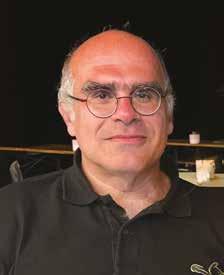
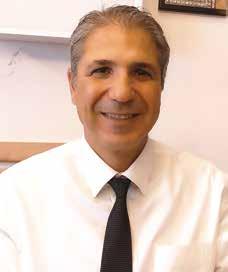



Lasers are now part of our everyday lives in a variety of applications. They have made things easier in many cases, and their use is becoming more necessary, more useful and easier. Often, their use is even required.
They are now widely used in healthcare and are very useful in the treatment of many conditions. For example, many surgical procedures are now carried out using laser technology, which makes the operation painless, harmless, bloodless and, of course, shorter, while the patient’s return to everyday life is naturally quicker as the recovery time is also reduced.
Lasers have also been used in physiotherapy for many years. Various types of lasers are used in physiotherapy clinics to improve the quality of treatment, reduce pain, inflammation, regenerate damaged tissue and generally reduce rehabilitation time, especially for musculoskeletal problems.
The use of lasers is particularly useful in the rehabilitation of tendinitis, tendinopathy, strains and other similar pathologies. The use of light with a dynamic focus and appropriate application directly contributes to the healing of tendon degeneration and, in combination with physiotherapy exercises, provides a solution to myotendinous problems.
The physiotherapist should be familiar with the use of laser nanometres, i.e. the wavelengths to be applied. They also need to know when to use continuous wave flow, when to use pulsed or hyper-pulsed flow and when to use variable flow. They should also know when to combine the wavelengths and how each of them will be emitted separately.
Lasers are a natural treatment for physiotherapists and are completely safe, with more studies and research done on them than any other physiotherapy treatment. In recent years, they have also been combined with cryotherapy: the application of cryotherapy before laser treatment helps the chosen wavelength or combination of wavelengths to penetrate deeper. The wattage of the laser is also important in achieving a greater depth of treatment.
Theofanis Th. Mountzouris
Physiotherapist graduate of Athens University of Applied Sciences, certified transmagnetic pump instructor, certified CHELT laser instructor.


Robotic surgery is performed with the use of the Da Vinci Xi Robotic System of the American company Intuitive, which through complex systems transfers the movements of the surgeon’s fingers from a controller to the tips of the instruments that have been previously placed in the body through 8 mm holes. The surgical precision is excellent and the method is bloodless.
Many people do not know that both robotic and thoracoscopic surgery address all diseases of the thorax and hemithorax (lung cancer, lung cysts, lung nodules, pneumothorax, hyperplasia of the thymus gland - treatment of myasthenia, thymomas) and are suitable for all ages.
With the passage of time, an increasing number of patients are now choosing the Minimally Invasive Methods as a unique way to treat chest diseases, as they do not require the classic thoracotomy, but 2 or 3 small incisions, do not require hospitalisation in an Intensive Care Unit, while minimising post-operative pain and complications, resulting in the patient’s immediate return to personal activities.
The Thoracic Surgery Clinic of Metropolitan Hospital with Director Mr Em. Georgiannakis, having recorded many pioneering achievements at European level, deservedly holds the title of Leader in Greece, but also in the whole of South-Eastern Europe.
Dr Emmanuel Georgiannakis is the most renowned thoracic surgeon in Greece in performing robotic and thoracoscopic surgery. Being the director of the Department of Minimally Invasive Thoracic Surgery of Metropolitan Hospital and Metropolitan General, but also a general trainer for the entire Southeastern Europe, he has performed a remarkable number of robotic thoracic surgeries that in July 2023 will reach 300, a number reflecting the amount of experience and ranking the department among the most experienced in the world. His training as an Advanced Fellow in Minimally Invasive Techniques took place at the Shanghai Chest Hospital of China, which signed a Memorandum of Association and Cooperation in April 2019 with the Department of Minimally Invasive Thoracic Surgery of Metropolitan Hospital.

When it comes to understanding gallstones, there are many misconceptions. From the causes of this condition to its treatments, numerous myths abound regarding this medical ailment. In order to shed light on what is true and false about gallstones, we are going to explore the underlying truth.

Gallstones are small, hard deposits that form in the gallbladder. These stones can vary in size and can be composed of cholesterol, bile salts, and bilirubin. Causes of gallstones include high levels of cholesterol in the bile, poor diet, obesity, and rapid weight loss. Contrary to common myths, gallstones are not caused by eating spicy or fatty foods, nor are they contagious.
A myth surrounding gallstones is that they can be caused solely by consuming fatty foods. While a high-fat diet can increase the risk of developing gallstones, there are other factors at play, such as genetics and certain medical conditions.
One common myth is that avoiding fats altogether is the best way to prevent gallstones, but in fact, a low-fat diet may increase the risk. Instead, incorporating healthy fats such as those found in olive oil and nuts, along with regular exercise, can help keep gallstones at bay. Additionally, staying hydrated with plenty of water and limiting alcohol and sugary drinks can also decrease the likelihood of gallstone formation.
Ultrasound can easily reveal the presence of stones in the gallbladder. It can also provide additional information, which can help surgeon’s strategy.
Maintaining a healthy lifestyle is crucial for the optimal health of your gallbladder. This small organ plays an important role in digestion, storing bile that helps break down fats. Without proper care, the gallbladder can become susceptible to the formation of gallstones, a painful and common condition. Eating a balanced diet, limiting alcohol consumption, and staying active are all important factors in maintaining a healthy gallbladder. By taking care of your body, you can ensure the best possible outcomes for your gallbladder health.
Treatment option is surgery: Laparoscopic cholecystectomy is the gold standard concerning surgical removal of the gallbladder, ensuring minimal scarring, faster recovery time and lower risk of wound complications, such as wound infection or postoperative hernia.

Finding a nodule in your thyroid gland is understandably worrying. Read why a potential surgery need not scare you, and why you should choose a qualified surgeon.

Nodules (swellings on or in the thyroid gland) are common, occurring in 40% of women and 30% of men during their lifetime.
While most thyroid nodules (90-95%) are benign, it is important to identify and treat malignant nodules.
• Malignant or suspicious nodules
• One or more nodules causing local symptoms in the throat, such as pain when swallowing, difficulty breathing, etc.
• A nodule that you find aesthetically disturbing.
• A nodule that causes hyperthyroidism (toxic adenoma) that cannot be otherwise treated.
• A large multinodular goiter (multiple nodules) that descends into the chest (submerged goiter).
Thyroidectomy is a common and, in skilled hands, safe procedure. It is performed under general anesthesia. You won’t feel a thing from the moment you fall asleep until you wake up.
The surgeon makes a small incision in the base of the neck, which is often unnoticeable after a few months. Once you have recovered from the anaesthesia, you may experience some mild pain or discomfort, but there are no restrictions on eating, speaking or moving.
Most patients go home the day after surgery and resume their normal activities immediately.
All scientific guidelines recommend that thyroidectomy should be performed by a surgeon who has received special training and systematically practises thyroid surgery (endocrine surgeon). Obviously, but also as studies have shown, complications are less frequent when the surgeon performs a large number of procedures per year.
• Nodules are usually assessed by ultrasound and needle biopsy.
• Thyroid surgery is a safe procedure in the hands of an experienced surgeon.
• The prognosis for thyroid cancer is very good.
• You can live a normal life after your thyroid gland has been removed.

Under a different name, Santorini Palace has been charted out on a long-term basis.
ΜΙΝOAN LINES

Enjoy
From the moment of embarkation until the arrival at the final port destination, the main objectives of the trained personnel of MINOAN LINES are the safety of their passengers and the assurance of a deluxe and comfortable travel experience. Begin your journey in one of the welcoming, hospitable, modern, comfortable, health safe lounges and public areas of the company’s cruise ferries, savoring your cup of coffee, meal, drink or dessert while enjoying the great blue color of the Greek seas.
The company has already completed 50 years of successful operation, it was founded in the Cretan city of Heraklion in 1972, and its course in the shipping sector began in 1974. Since then, it has played a leading role in the routes it serves and has set the standards in travel innovation, holding a prominent position among the foremost passenger ship companies in Greece as well as in Europe.
Since 2008 MINOAN LINES has been a member of the Italian Grimaldi Group, one of the largest carriers of vehicles and machinery of all types (roll-on/roll-off), containers and passengers in the world. The Grimaldi Group is headquartered in Naples, Italy, with branches in more than 25 countries, 17,000 employees and over 130 vessels approaching more than 140 ports worldwide.
The network of MINOAN LINES covers a wide range of domestic and foreign tourism. With our luxurious and ecological ships, we connect with the domestic routes, Heraklion, Crete and Piraeus and with the Adriatic routes, Greece with Italy. Cruise Ferries KNOSSOS PALACE and FESTOS PALACE make the trip more pleasant and comfortable than ever, connecting Piraeus with Heraklion with daily departures. In addition, during the summer season, a direct connection is offered from Piraeus and Heraklion with the island of Aphrodite, the enchanting Milos, in just a few hours, with the floating palaces KNOSSOS PALACE and FESTOS PALACE with daily itineraries from late June to early September, on the route Piraeus – Heraklion – Piraeus. With regard to the selection of accommodation categories, it is worth noting that MINOAN LINES offers various cabin and accommodation categories on its ships. You can choose to travel in economy class, enjoying the services in one of the spacious and comfortable lounges of the ship, in the new V.I.P. seats, which offer privacy and comfort in a specially designed area of the ship, or in one of the different cabin categories, depending on your needs, whether you are travelling alone, with friends or with your family. In fact, for those travelling with their beloved four-legged friends, MINOAN LINES offers specially designed Pet cabins if you wish to be with them during the journey.
Also, for lovers of Italy, it is worth noting that the ship KYDON PALACE operates on the route Igoumenitsa - Brindisi. Under the Greek flag and Greek crews, the daily itineraries of KYDON PALACE are operated, in conjunction with the itineraries of M/V IGOUMENITSA, by Grimaldi Euromed S.P.A.
Apart from the unparalleled aesthetics and luxury, the high safety, quality and comfort of our company’s vessels, every passenger of MINOAN LINES can enjoy during the trip, depending on the category of the vessel traveled, a wide range of services.
Shop for select products at one of the stores on board - treat yourself or buy for your beloved ones. Hop on-line on your own smartphone, tablet or laptop from the comfort of your coach or seat, using Wi-Fi services available.

Πέρα
Regarding the meals options, in the two restaurants, A la carte and Self Service, of our cruise ferries KNOSSOS PALACE and FESTOS PALACE, the experienced chefs will travel you with their gastronomic creations and quality ingredients, many of which are produced from the fertile soils of the Cretan land. Dining options include an A la carte and a Self Service restaurant, where experienced chefs take diners on a gastronomic

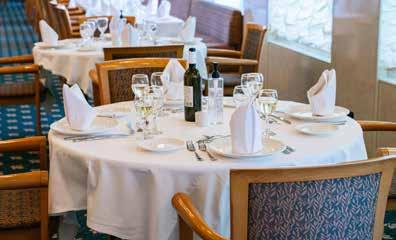
journey with their culinary creations, made with quality ingredients, many of them being the fruits of the fertile Cretan soil.
Comfort, luxury and quality services on board are combined with the hospitality and courtesy of our vessels’ staff to travel you quickly and safely to your favorite destinations!
MINOAN LINES, since their establishment, have recognized their responsibility towards society and seek to act and operate actively and consistently within the principles of Corporate Social Responsibility by developing innovative actions and presenting important social work.
The company always strives, based on its anthropocentric philosophy, and with full respect towards its principles and values, to encourage and reward worthwhile initiatives and efforts.
Being aware of its social role and in the context of its corporate strategy and commercial policy, MINOAN LINES promotes an integrated, coordinated, quality and significant social work, by setting important goals, actively participating and supporting, on an annual basis, through sponsorships (financial support or free / discounted tickets with the cruise ferries of MINOAN LINES’ fleet) socially vulnerable groups, various cultural associations, social organizations, sports clubs, organizations, educational and charitable institutions, aiming for the prosperity of the society as a whole and its progress.
All in all, we must emphasize that in the rich plan of Corporate Social Responsibility activities, the cultivation of environmental awareness and sustainable development are promoted. MINOAN LINES is the first company in the field of Greek passenger shipping that fully complies with the new requirements of the International Maritime Organization (IMO), having invested and completed the installation of exhaust gas cleaning devices (SCRUBBERS), in the high-speed ferries KNOSSOS PALACE, FESTOS PALACE and KYDON PALACE, converting them into more environmentally friendly vessels.
MINOAN LINES does not just follow developments, it pioneers in them and continues to be on a growth trajectory by investing in the future and development of the tourism product for the benefit of our country.





TOURISM AWARDS
Search Engine Optimization (SEO) Strategy
Social Media Presence/Παρου-
Minoan Lines
(Travel Experience),
inoan Lines is the most highly regarded shipping company in Greece and Europe. It has won several quality awards and top distinctions for its vessels, services and outstanding professional standards from a number of highly rated institutions and publications, as follows:
TOURISM AWARDS 2024
GOLD AWARD in the category Promotion of Local Greek Cuisine, under the nomination title "Journey to Cretan Gastronomy / Greek Inspired Gastronomy Restaurant"
TOURISM AWARDS 2022
GOLD AWARD in the Corporate Social Responsibility Actions category, with nomination title «Minoan Lines is always close to the society and its values!»
GOLD AWARD in the Social Media Presence category, with the nomination title: “Minoan Lines continues its dynamic presence in Social Media”.
TOURISM AWARDS 2021
GOLD AWARD in the Search Engine Optimization (SEO) Strategy category, with the nomination title “Optimization of SEO Strategy in 5 countries”.
GOLD AWARD in the Social Media Presence category. Minoan Lines continues its dynamic presence in social media (Facebook and Instagram).
TOURISM AWARDS 2020
GOLD AWARD for Travel Experience, in the Travel section/category.
GOLD AWARD for the Online Strategy of Minoan Lines, in the Online Strategy section/category.
GREEK HOSPITALITY AWARDS 2020 & 2018
Travel.
Online Strategy.
Online Strategy
GREEK HOSPITALITY AWARDS 2020 & 2018
TOURISM AWARDS 2019
Lines,
Branding / Public Relations / People Strategy.
ΧΡΥΣΟ
Attractions & Destinations
CORPORATE SUPERBRANDS
ICAP GROUP 2018 &
«True Leader»
TOURISM AWARDS
“Best Greek Coastal Shipping company”.
TOURISM AWARDS 2019
GOLD AWARD for the Support of Local Communities and Corporate Social Responsibility actions, implemented by the company, in the Branding / Public Relations / People Strategy category.
GOLD AWARD for the “New Destinations” in the Attractions & Destination category.
CORPORATE SUPERBRANDS 2018-2019 & 2016-2017
“Top Corporate Brand Name in the Sea Transportation Sector”.
ICAP GROUP - 2018 & 2017
“True Leader” in the category “Maritime Shipping”.
TOURISM AWARDS 2018
GOLD AWARD for MINOAN LINES BONUS CLUB, the pioneering and flexible customer loyalty program.
GOLD AWARD for the reduction of the energy footprint of the company's vessels and the protection of the environment.
GOLD AWARD for the integrated On-Line Digital Campaign entitled “Away with the Müllers”.
TOURISM AWARDS 2017
GOLD AWARD in the category “Supporting local communities / Actions of Corporate Social Responsibility”.
GOLD AWARD in the category “Online presence and communication” for the NEW Minoan Lines’ Online Booking System.
LLOYD’S LIST GREEK SHIPPING AWARDS 2016
“Passenger Line of the Year”.




Το πρωτοποριακό ΠΡΟΓΡΑΜΜΑ ΠΙΣΤΟΤΗΤΑΣ ΕΠΙΒΑΤΩΝ των ΜΙΝΩΙΚΩΝ ΓΡΑΜΜΩΝ, έχει συμπληρώσει 472.000 μέλη στα 19 χρόνια επιτυχημένης λειτουργίας από την έναρξη του, αποδεικνύοντας την τεράστια απήχηση του στο επιβατικό κοινό στην Ελλάδα και το εξωτερικό!
Χρυσό Βραβείο στο Minoan Lines Bonus Club στα Tourism Awards 2018 & Ασημένιο Βραβείο στα Προγράμματα Επιβράβευσης Τourism Awards 2021 & 2022. Προνόμια:
•

The truly innovative customer loyalty program of Minoan Lines now has 472.000 members and 19 years of successful operation from the launch, demonstrating its enormous appeal to the passenger public in Greece and abroad.
Gold Award for Minoan Lines Bonus Club at Tourism Awards 2018 & Silver Award for Loyalty Programs at Tourism Awards 2021 & 2022.
Benets:
• 10-20% discount on CRETE, MILOS, ADRIATIC routes.
•Free tickets in all accommodation and private vehicle categories.
•10-20% discount at the bars and restaurants on board.
•10-15% discount at the stores on board.
• Promotions and offers only for members.
*Not applicable on ixed dues.
YOUR BONUS CLUB CARD IS AVAILABLE DIGITALLY!
Minoan Lines Bonus Club goes digital! We have good news for you!
As a Minoan Lines Bonus Club member, you don’t need to have a physical card in order to enjoy all the benefits.
Log in to your Minoan Lines Bonus Club account at www. minoan.gr and download your digital loyalty card, print it or save it to your smartphone, tablet or laptop for quick access to your membership details.









